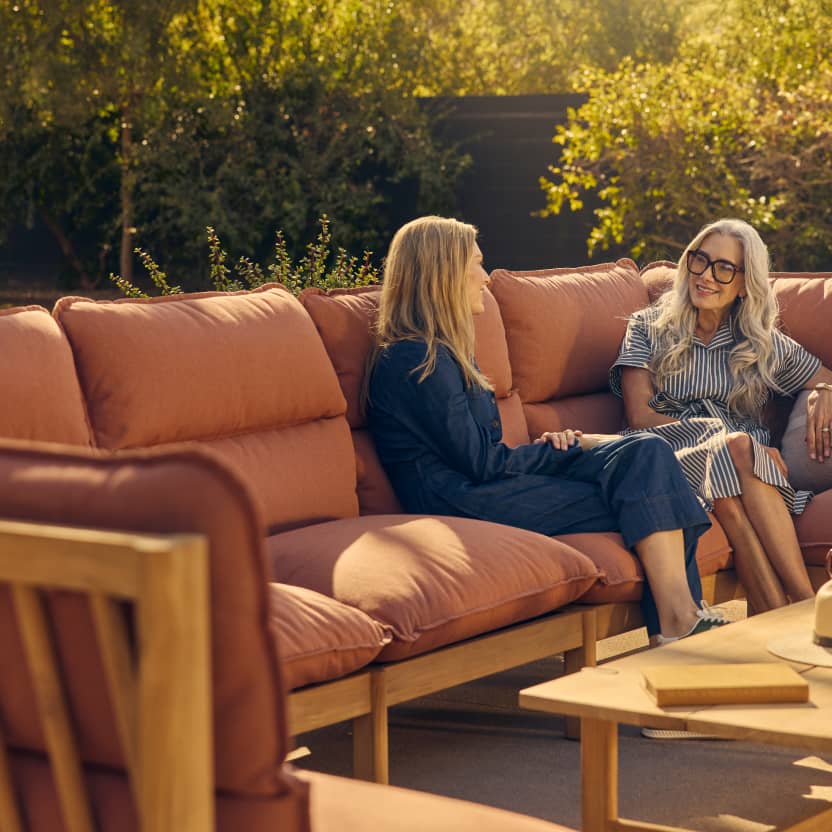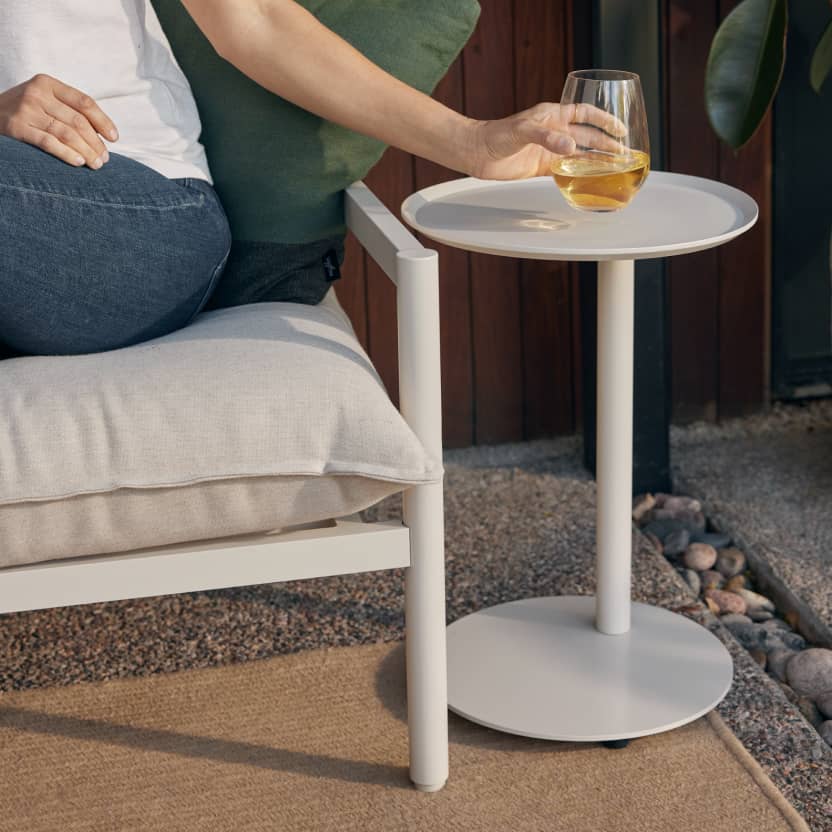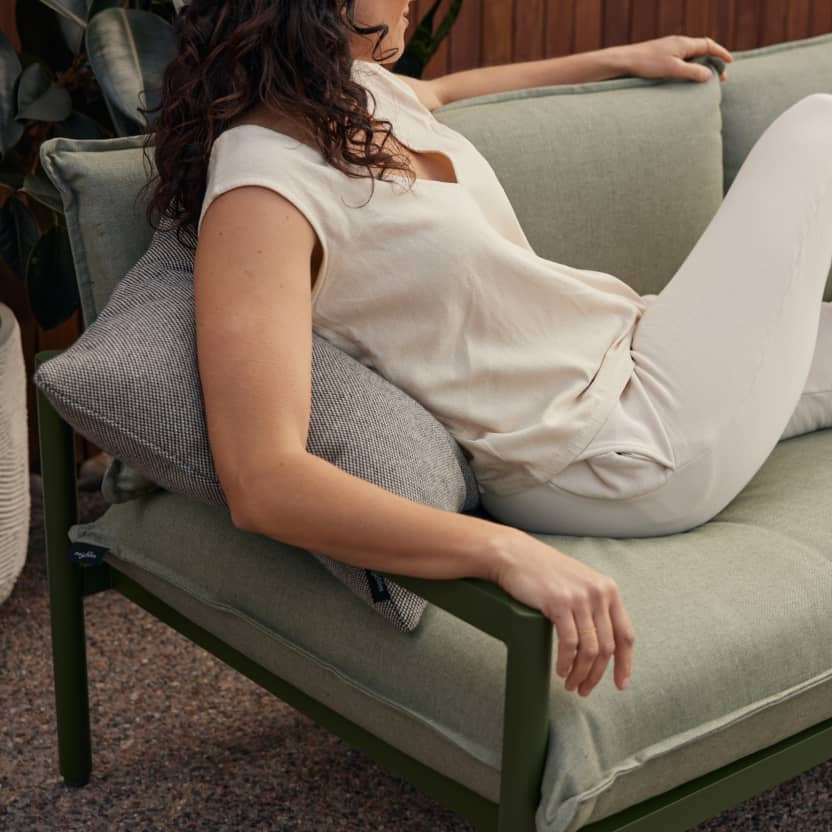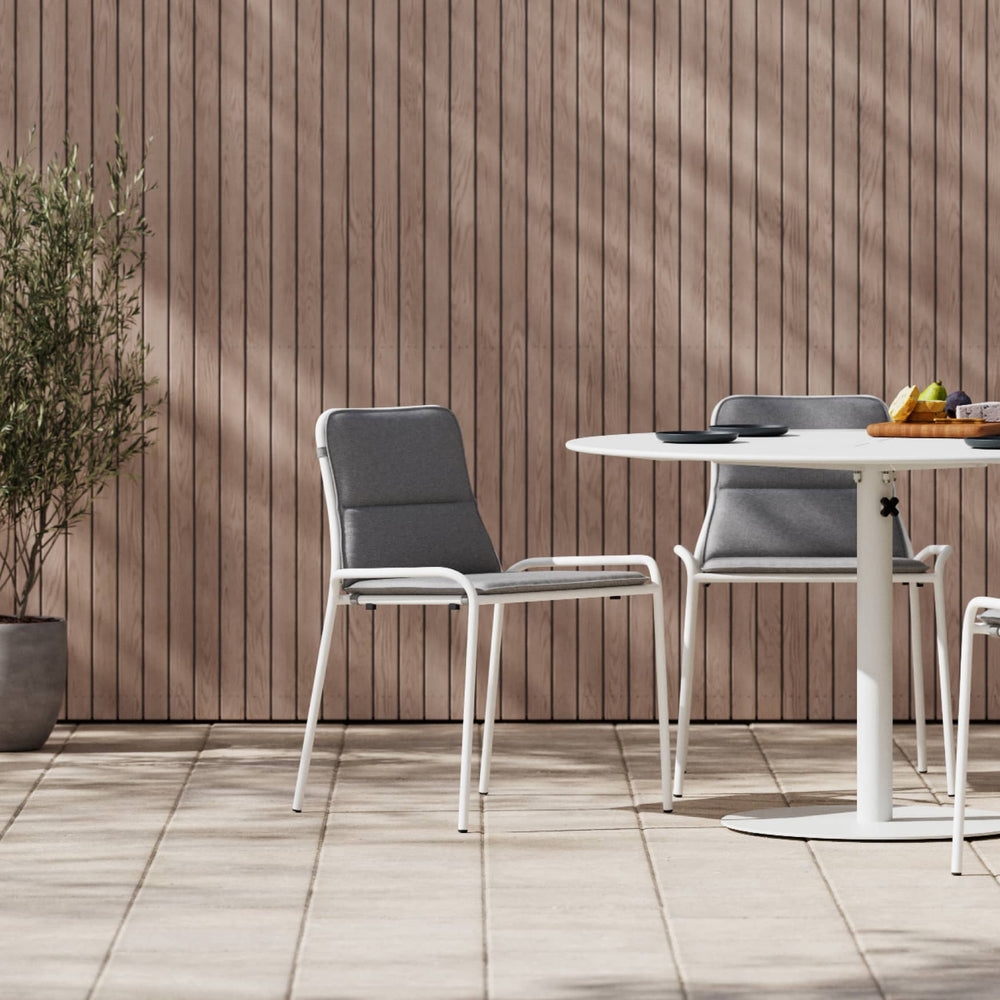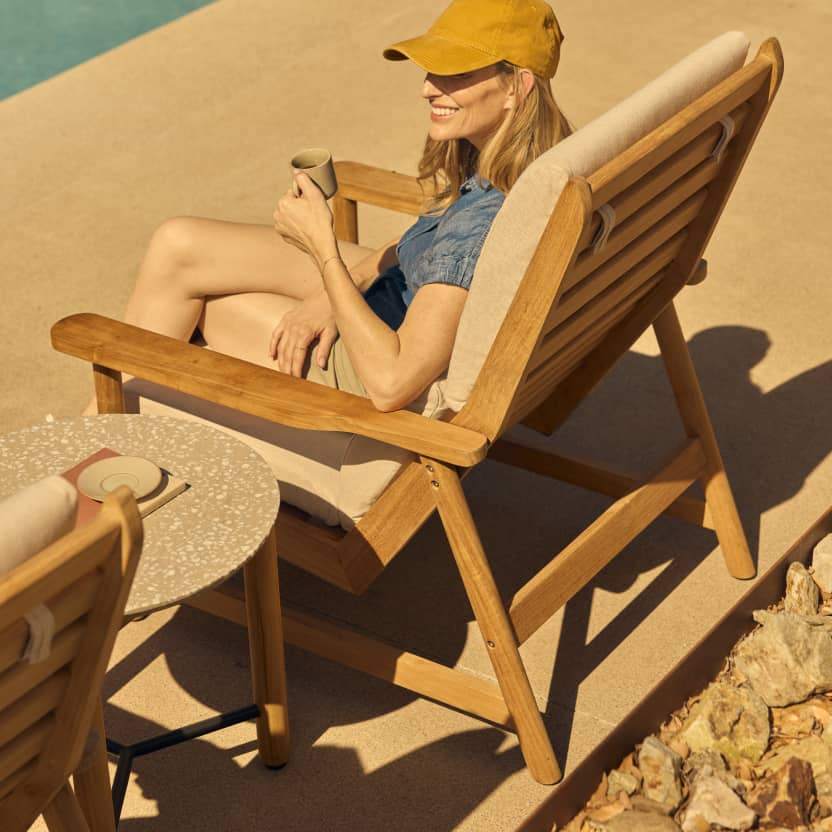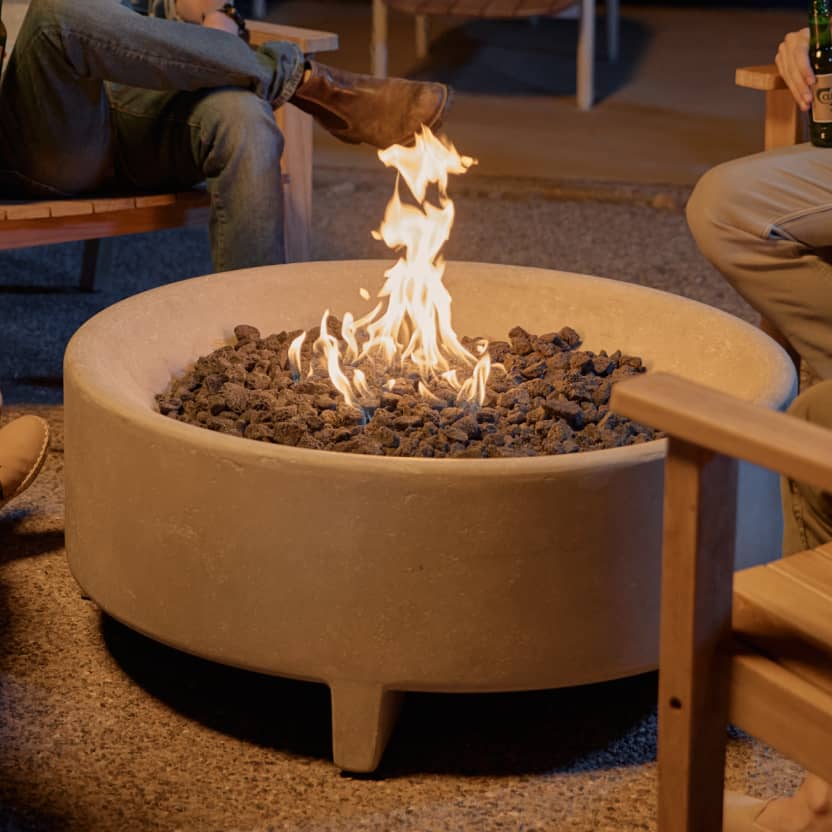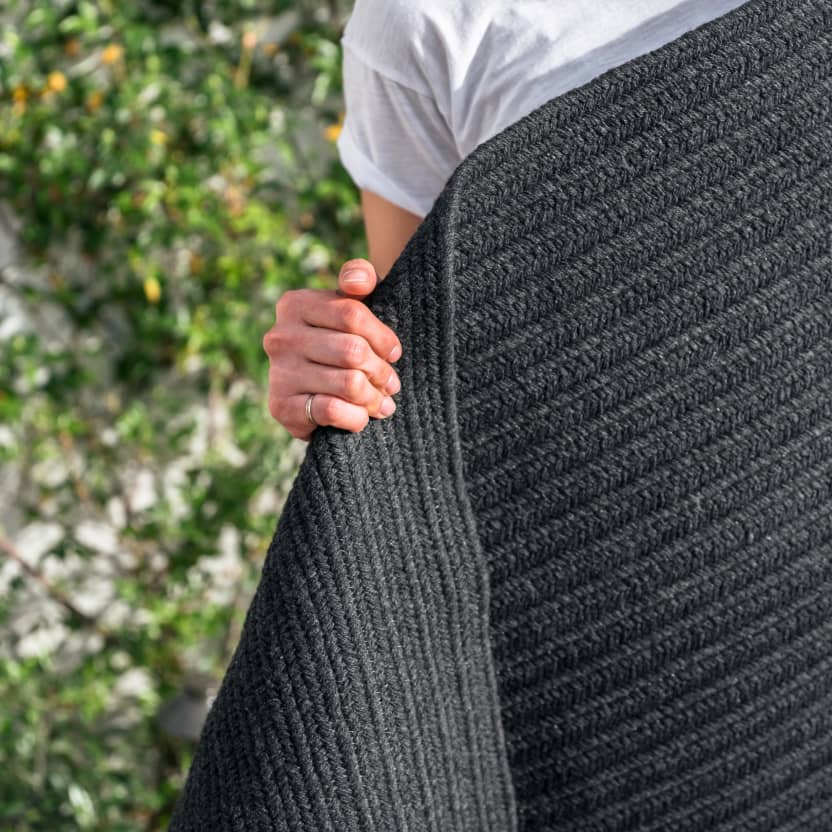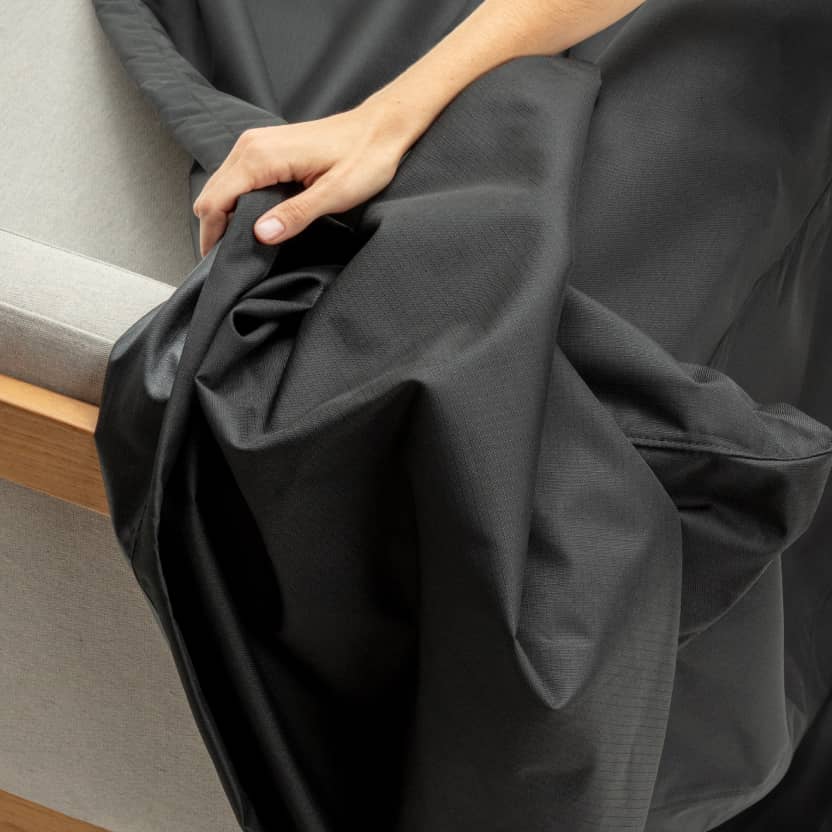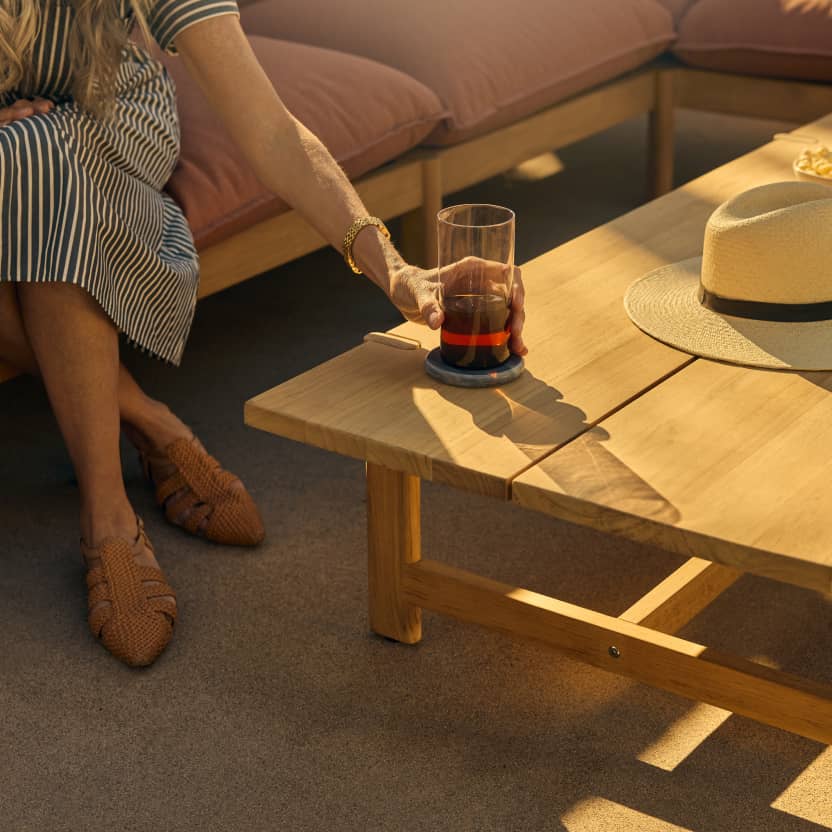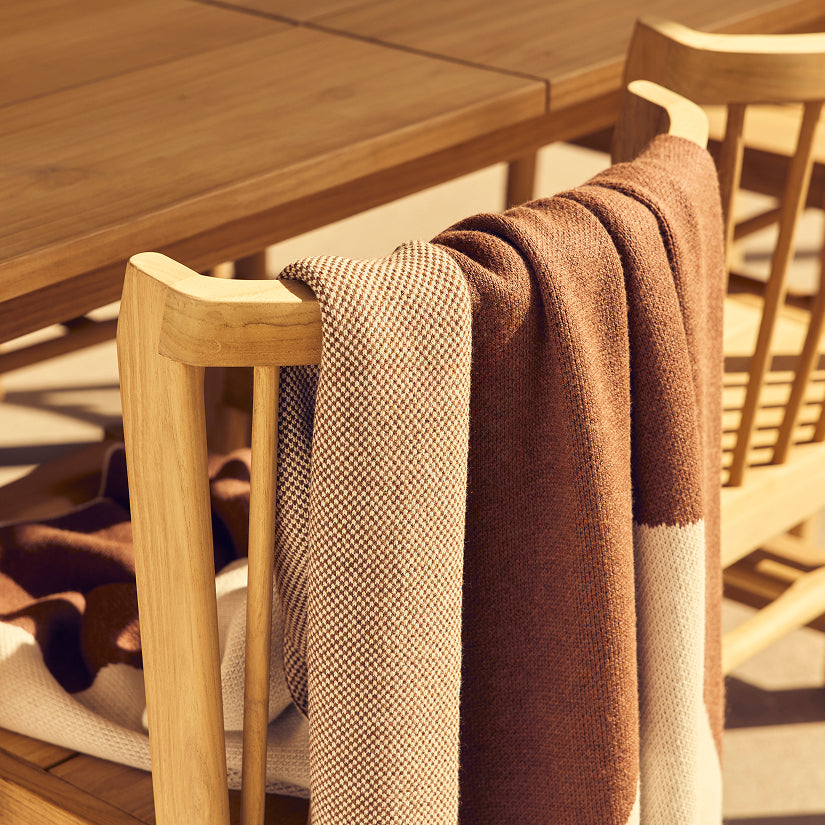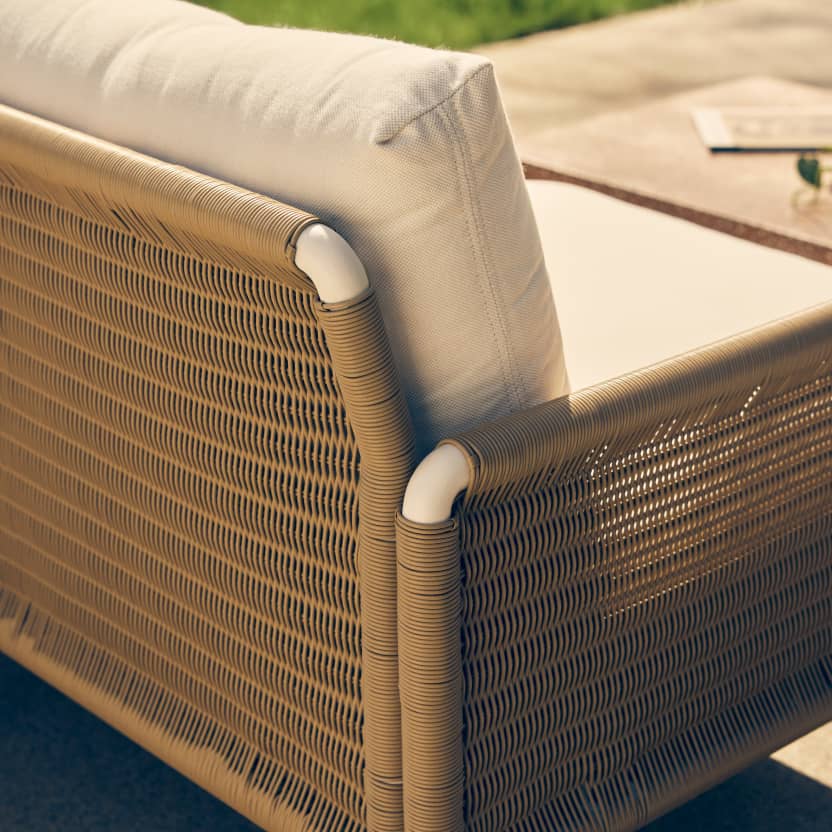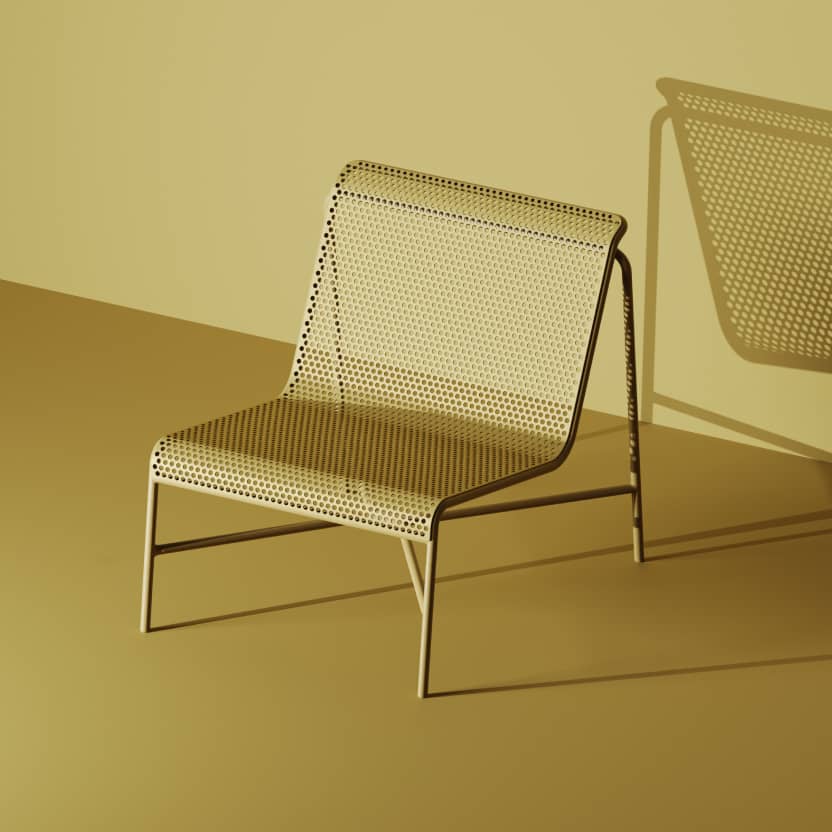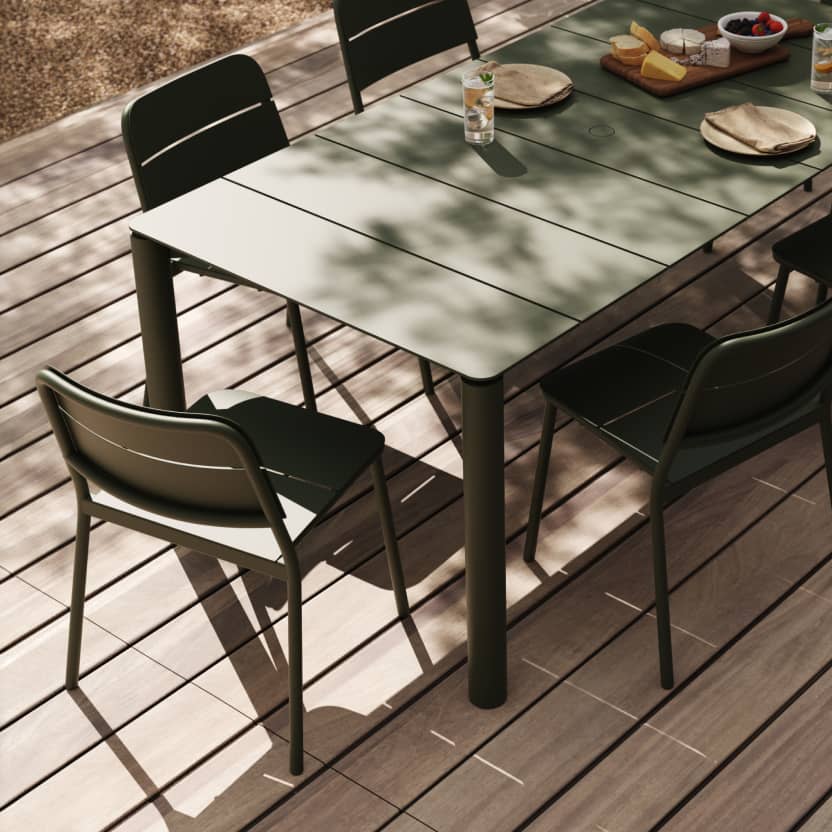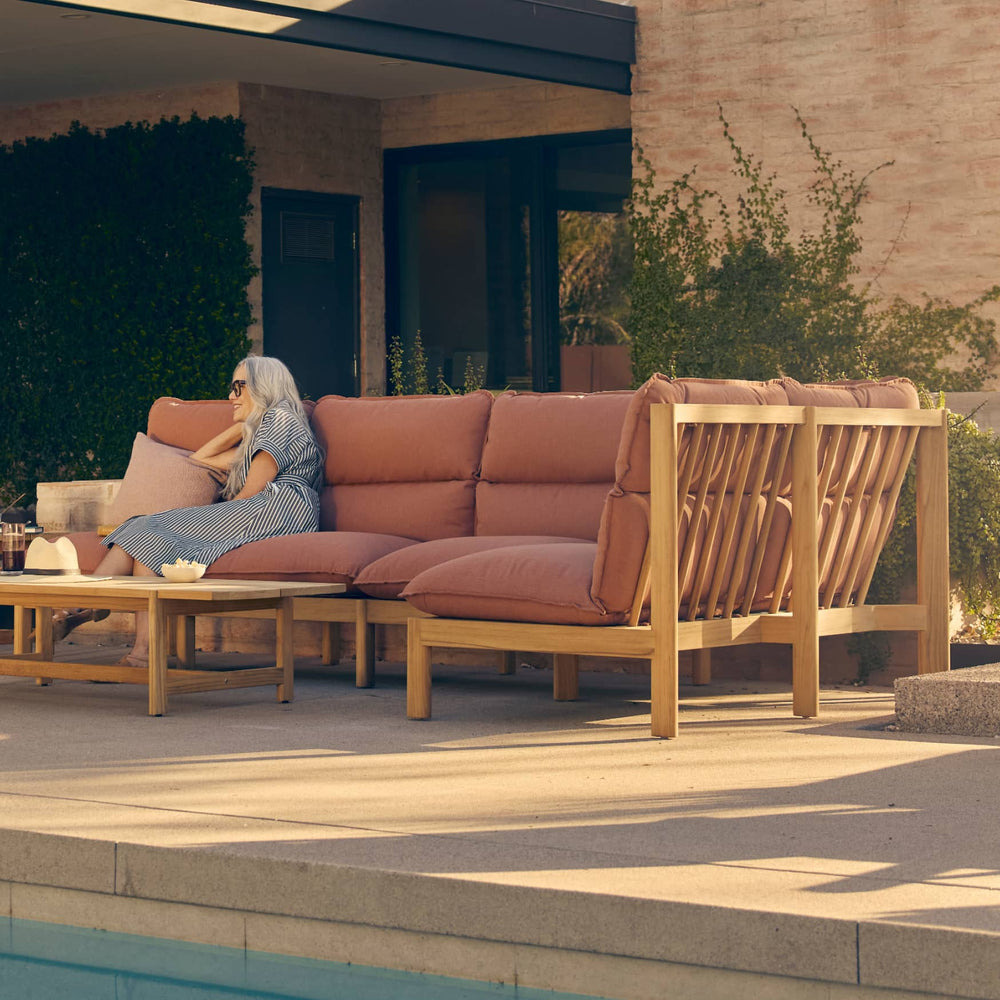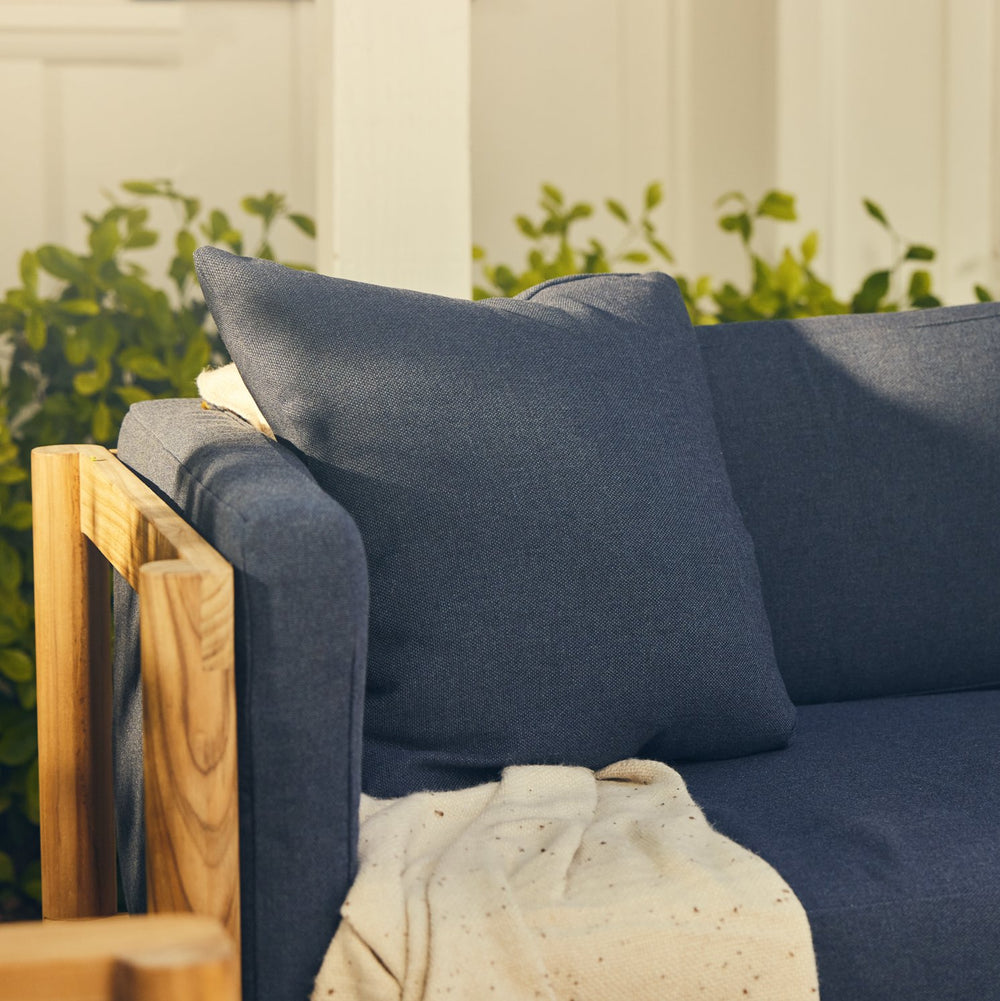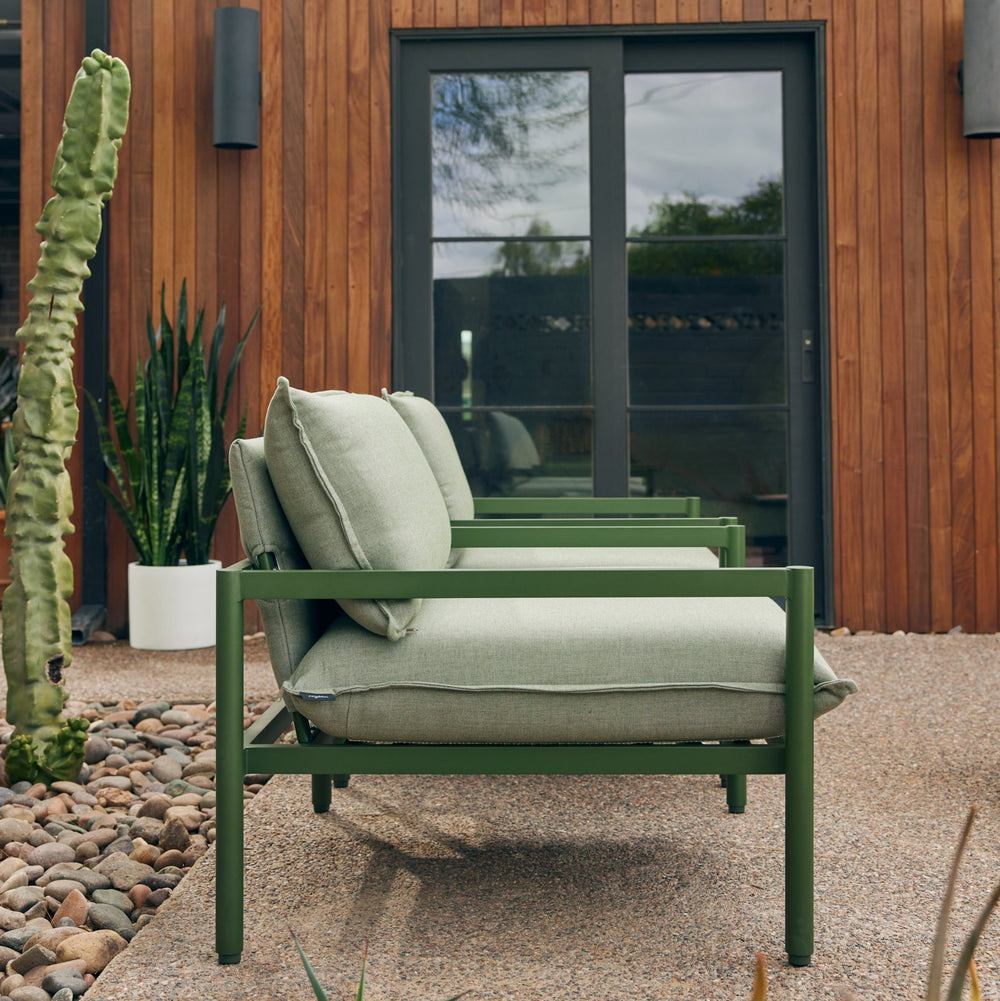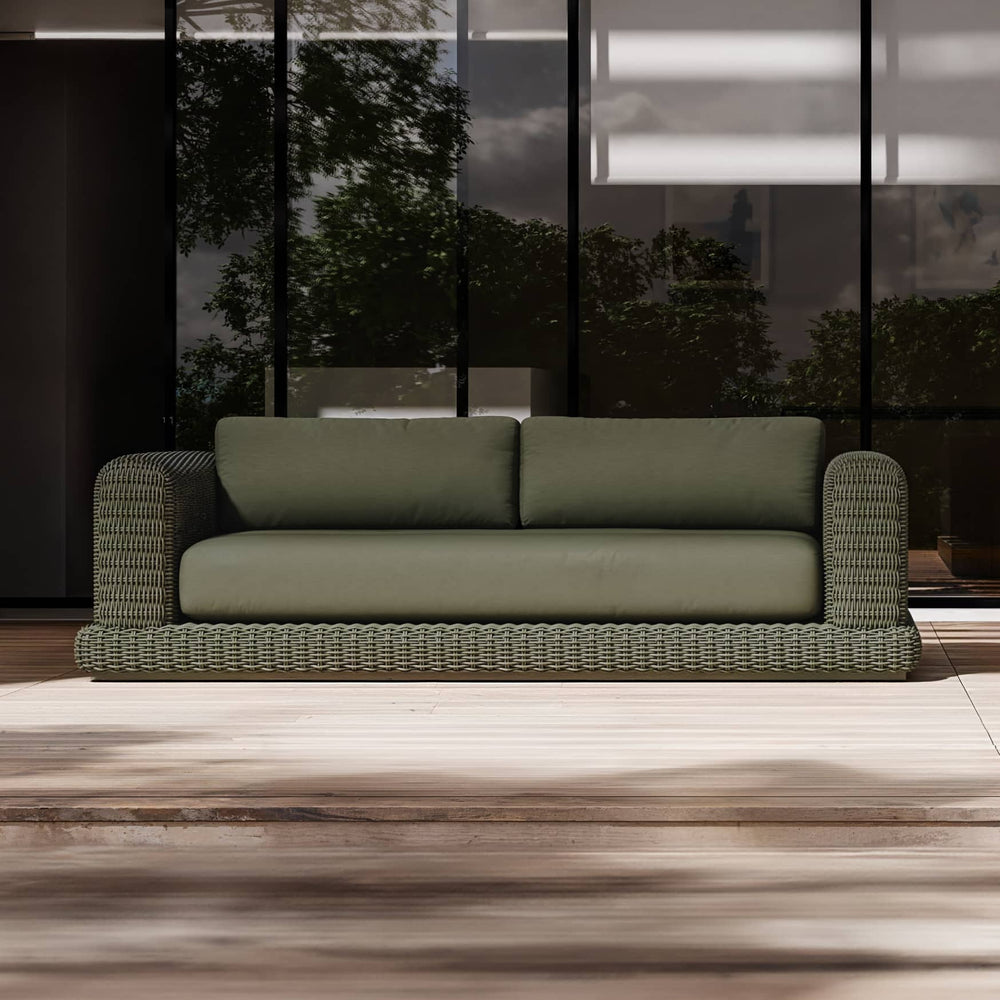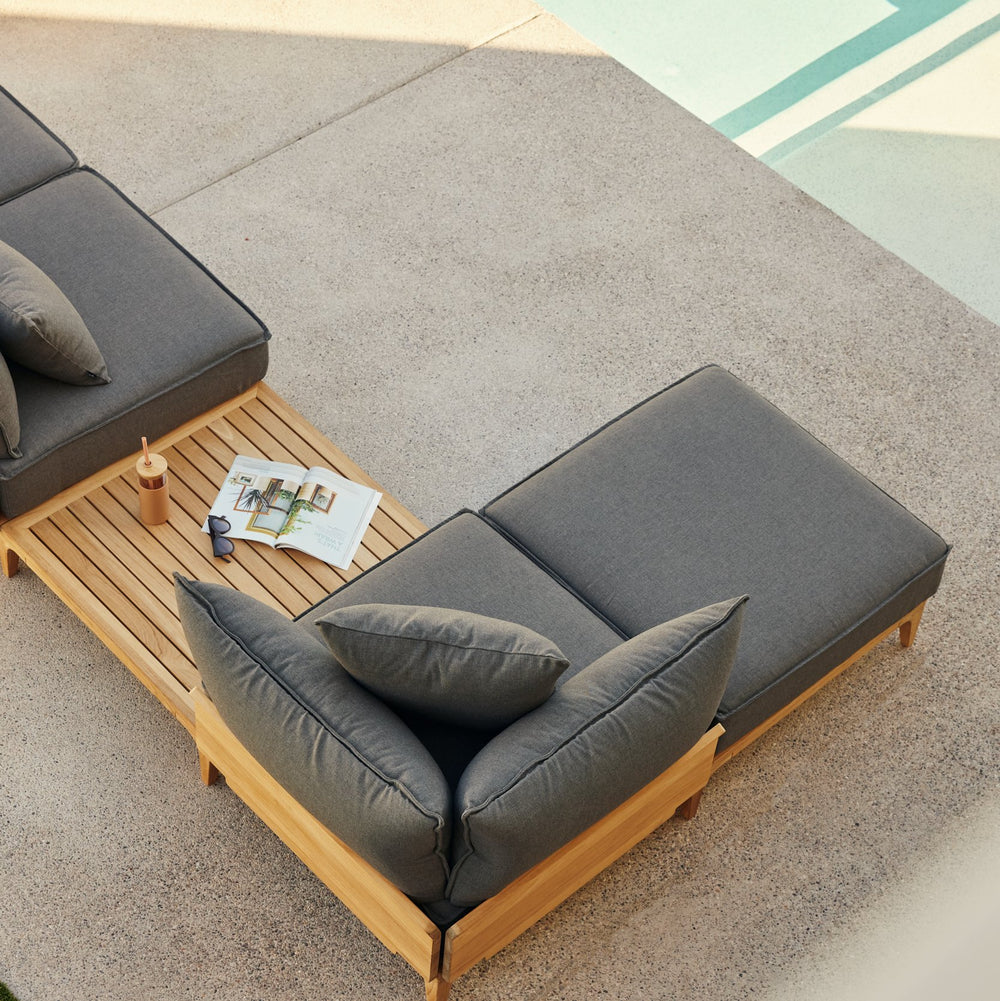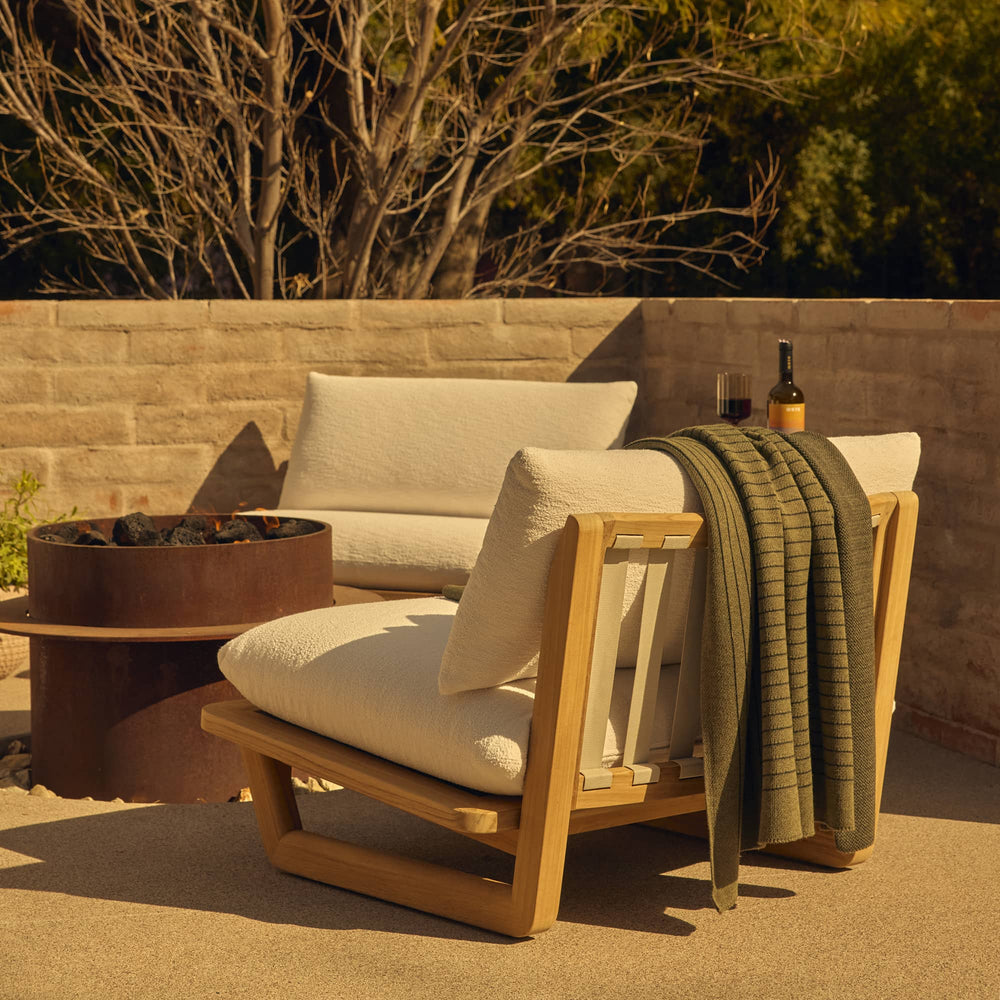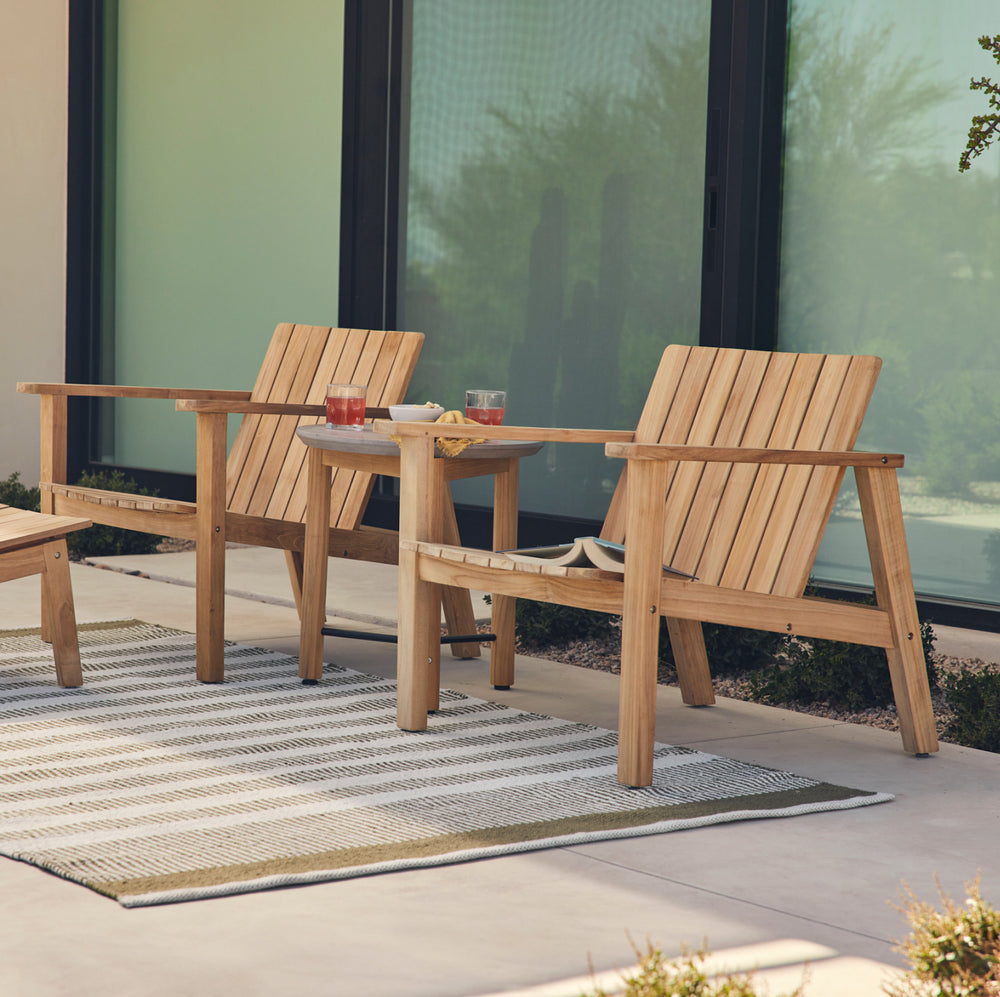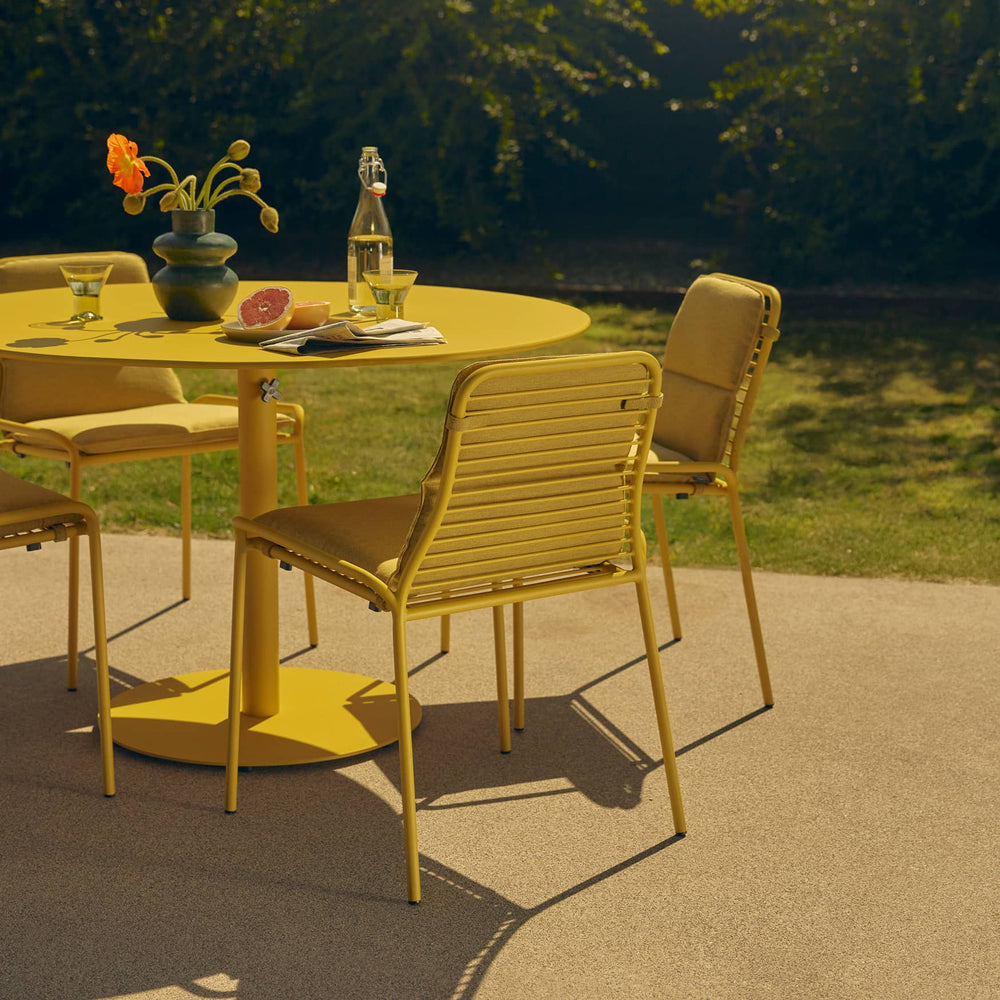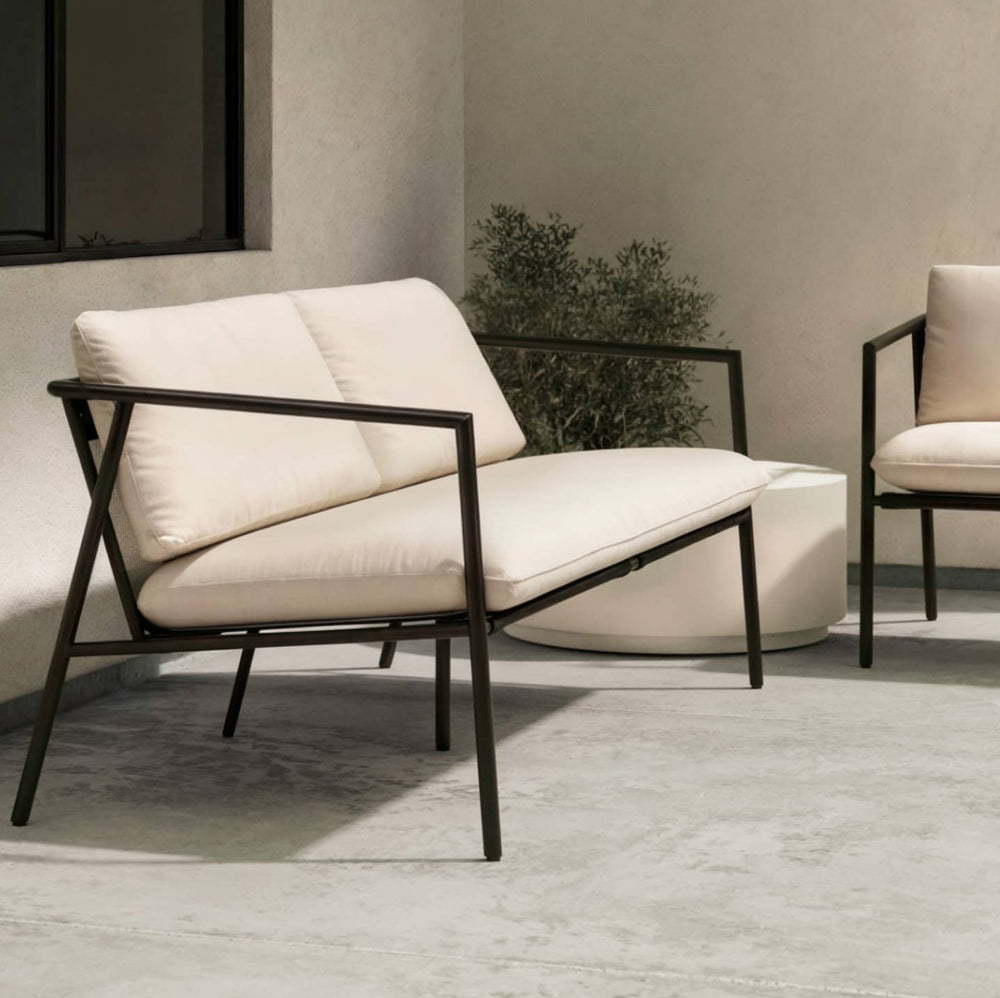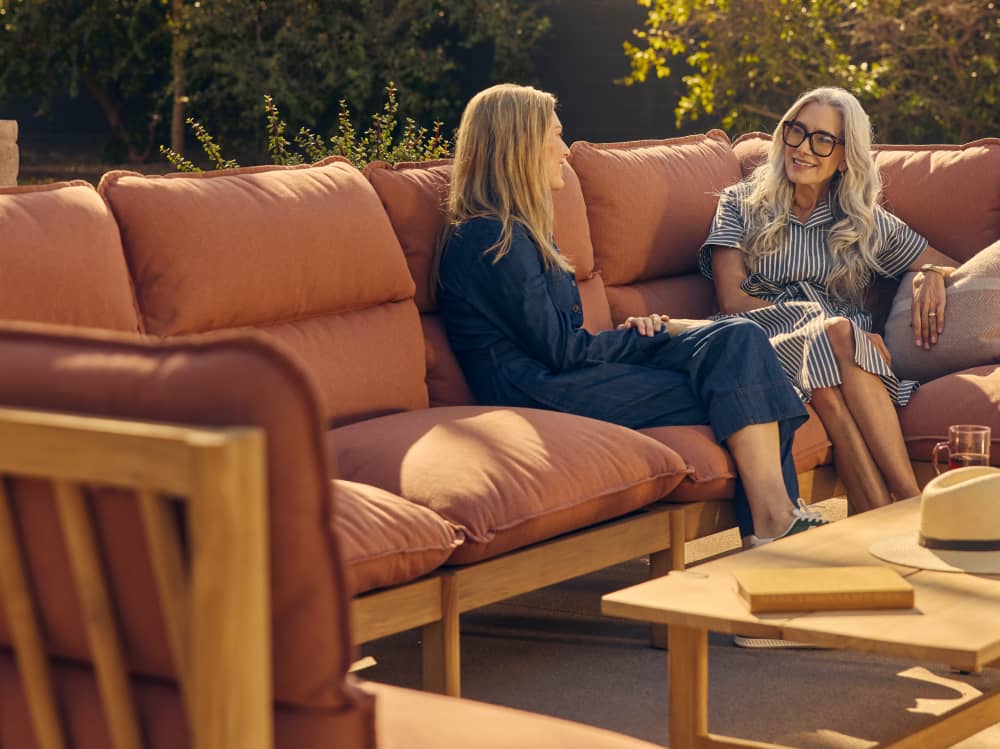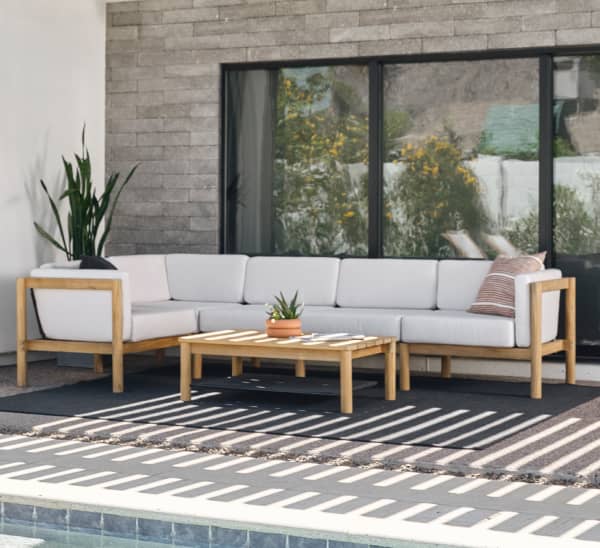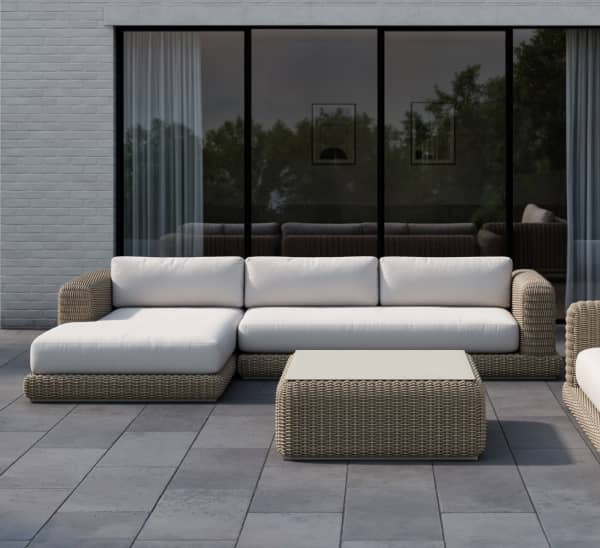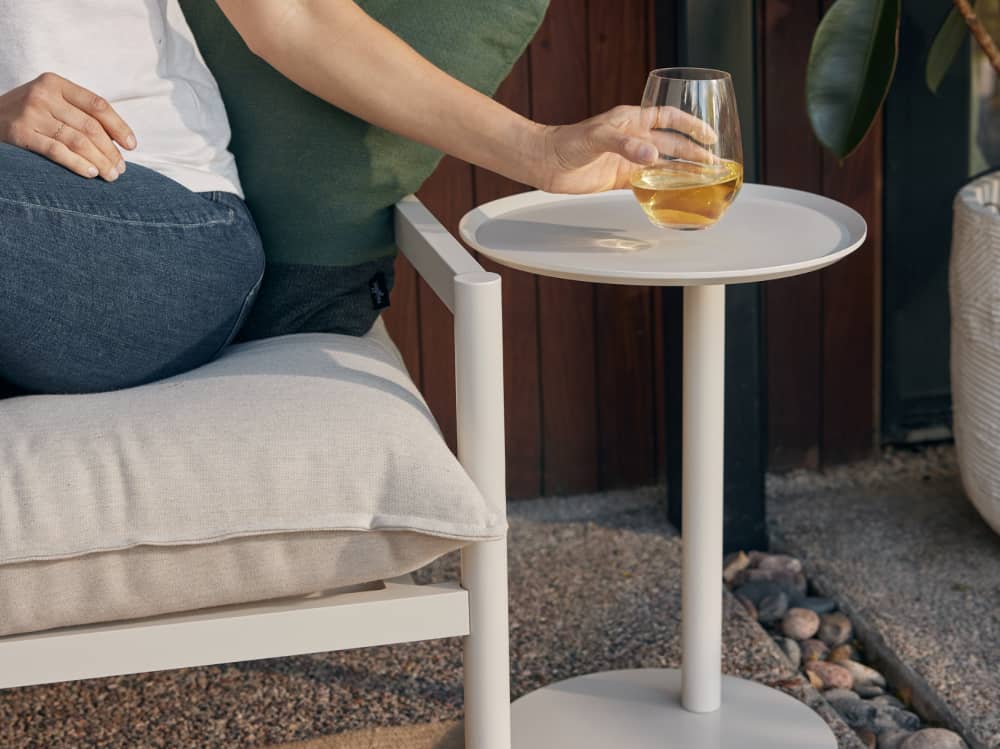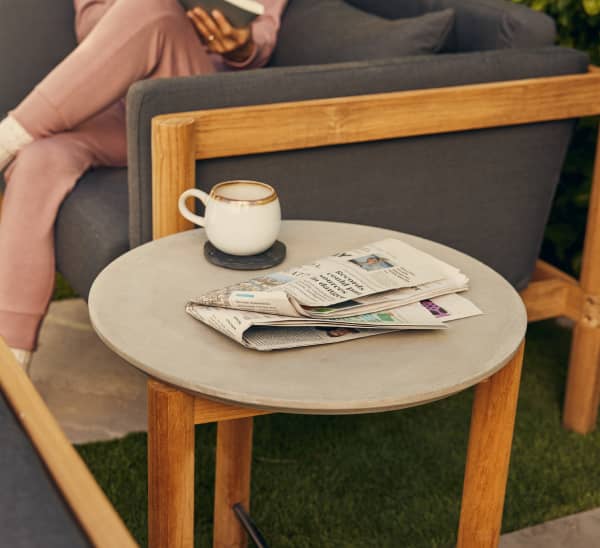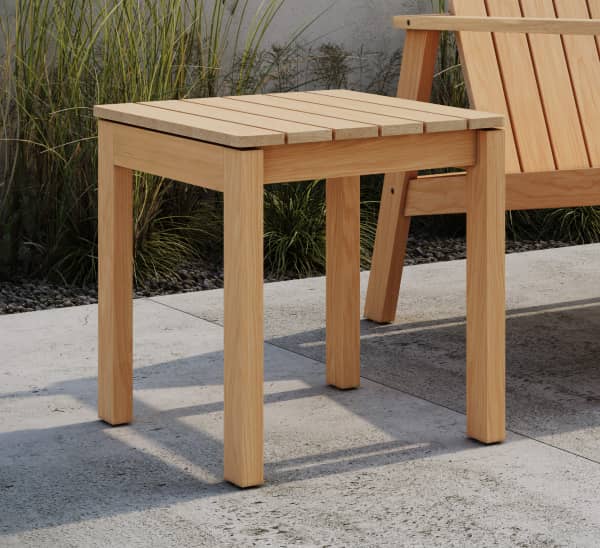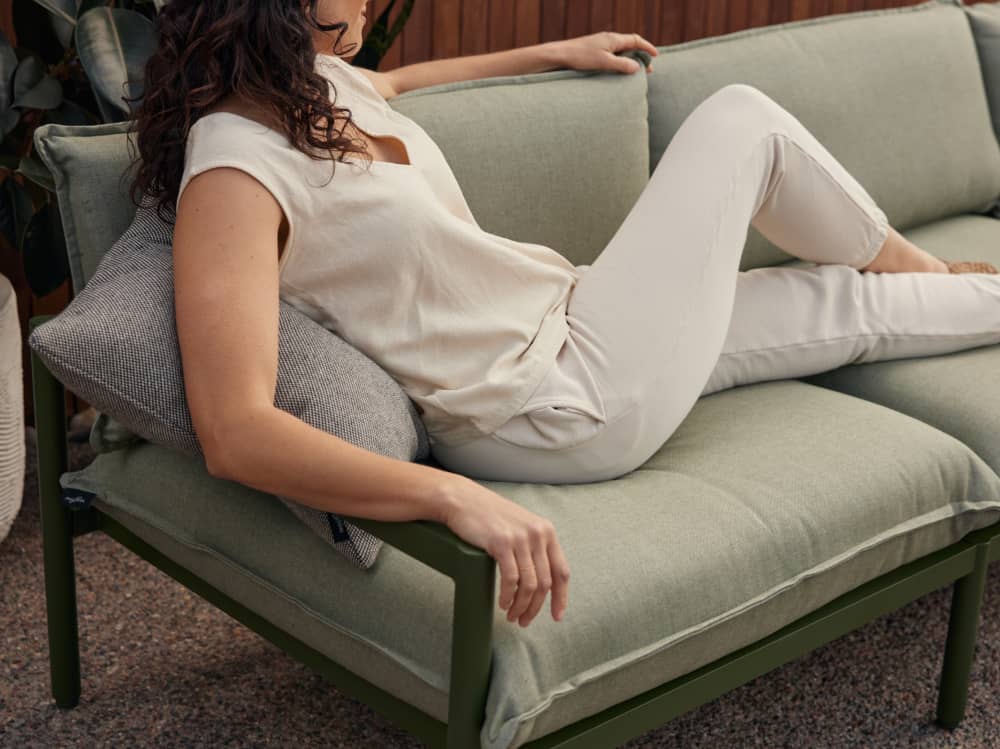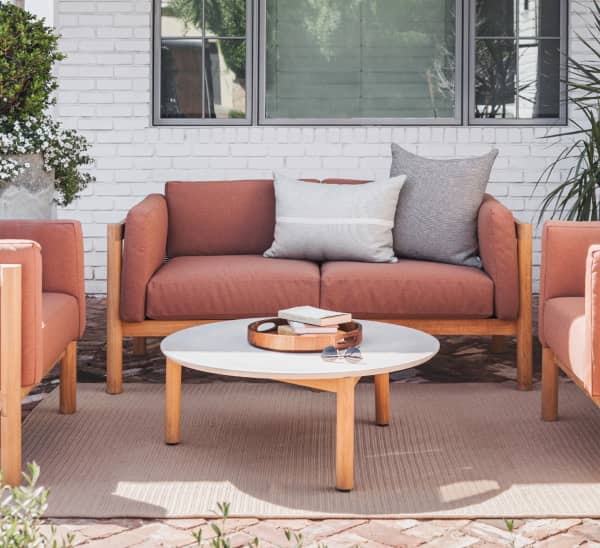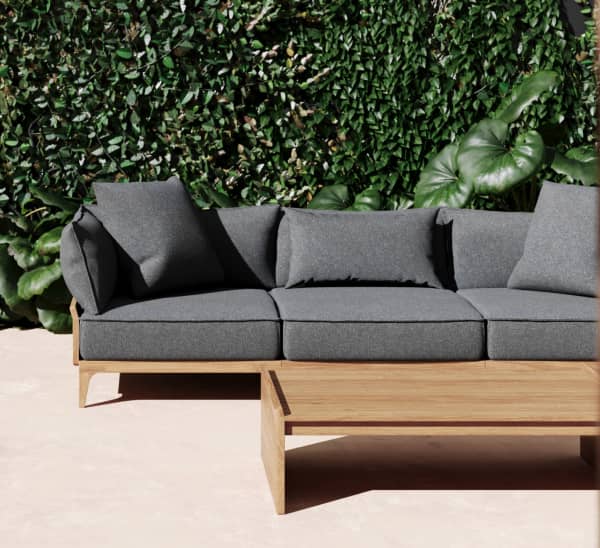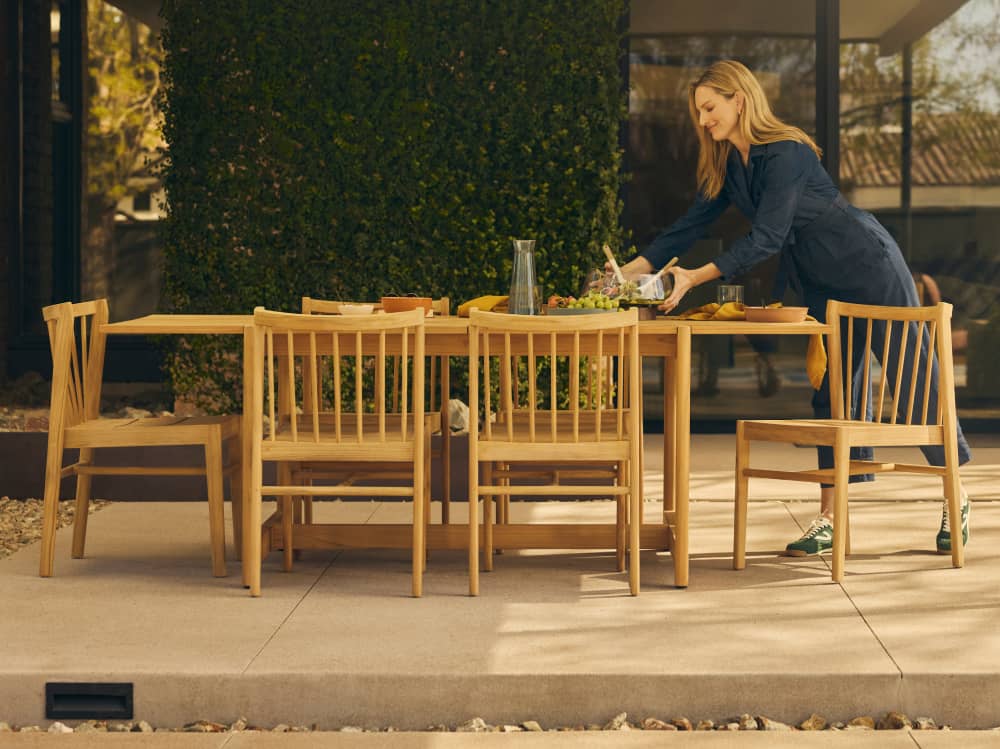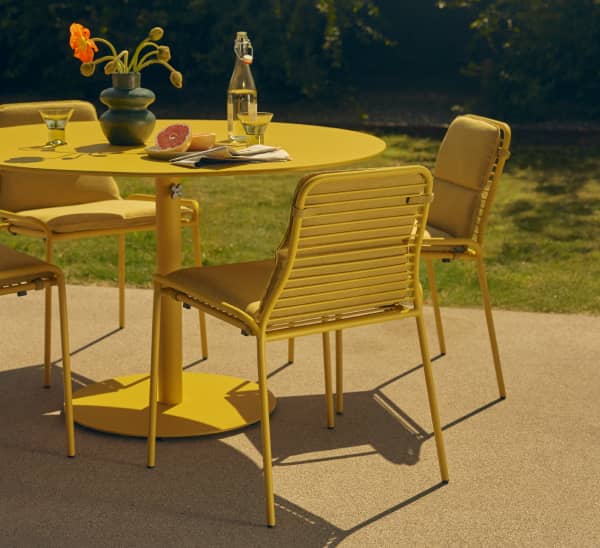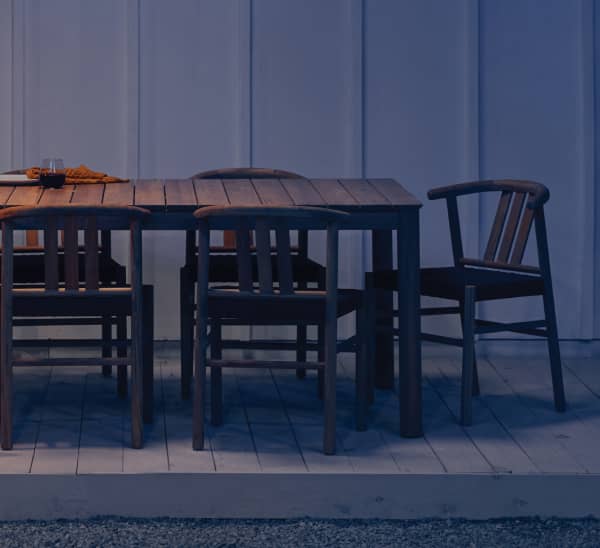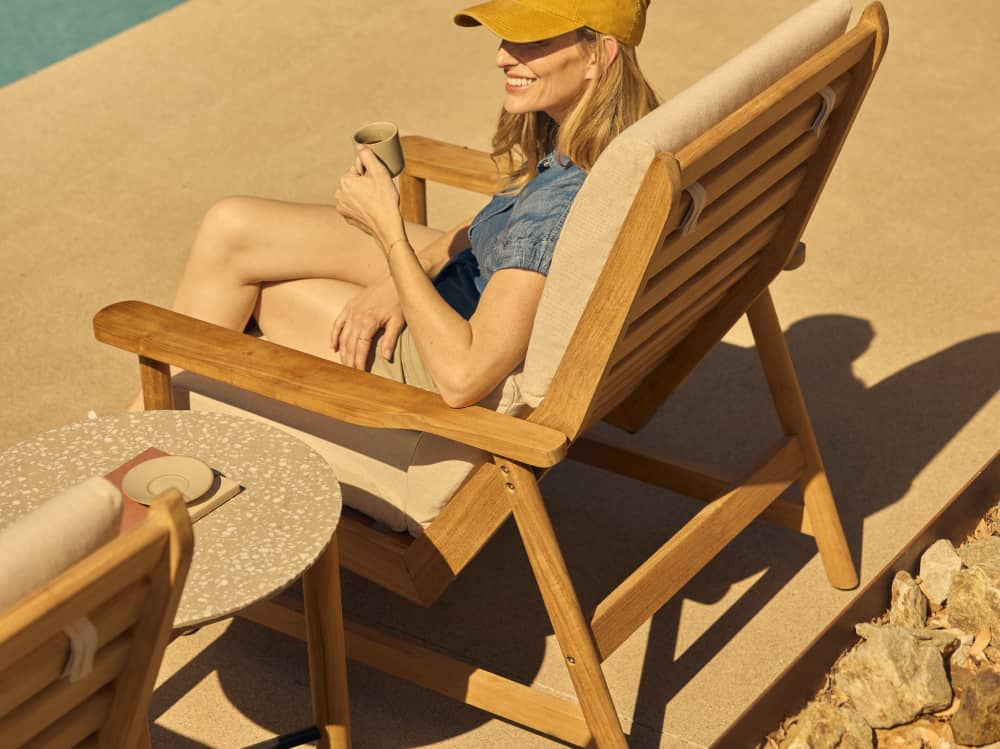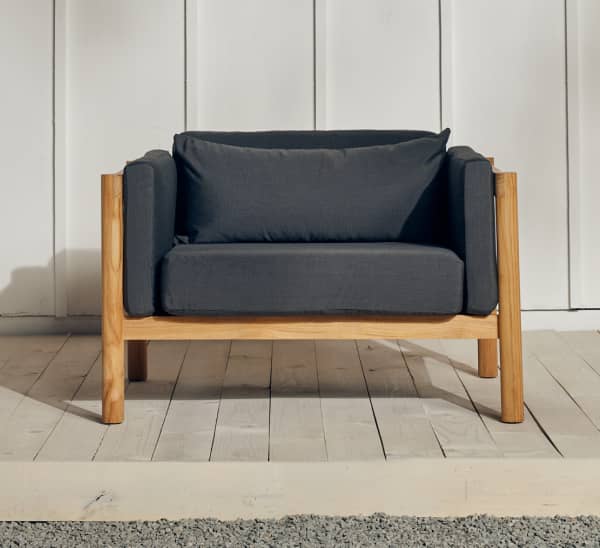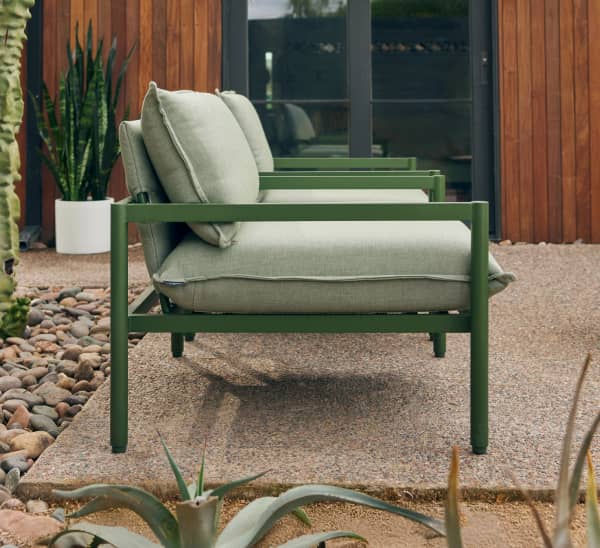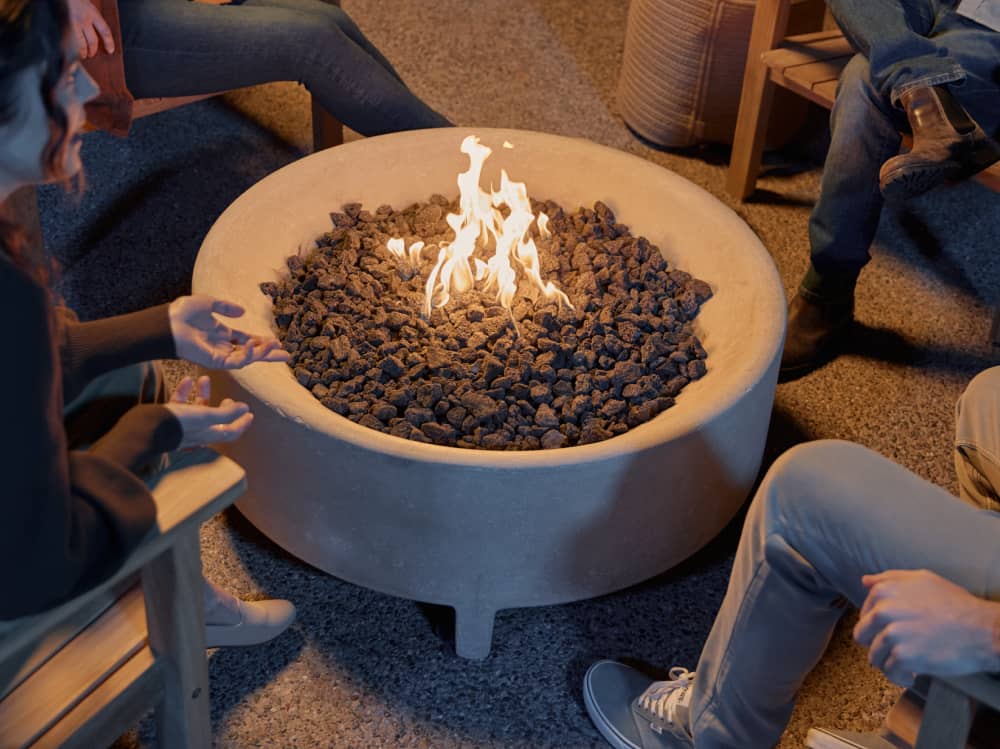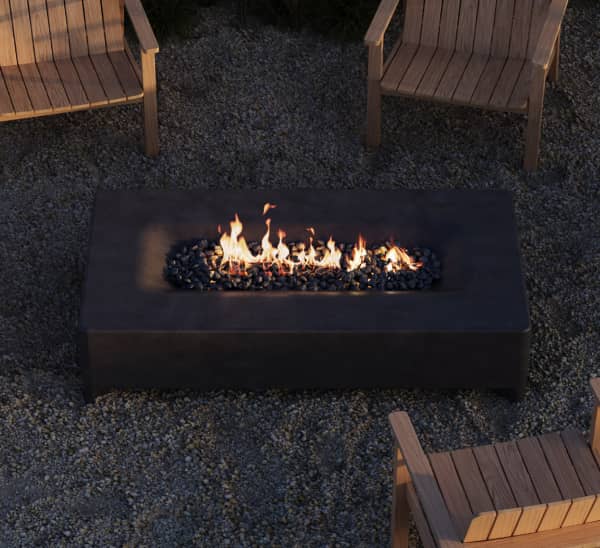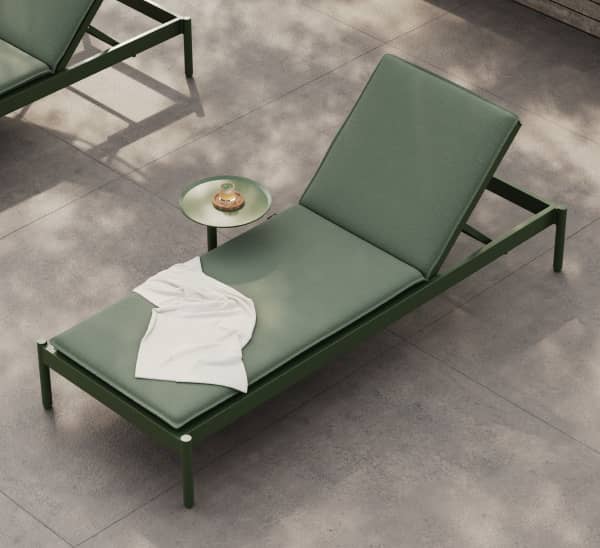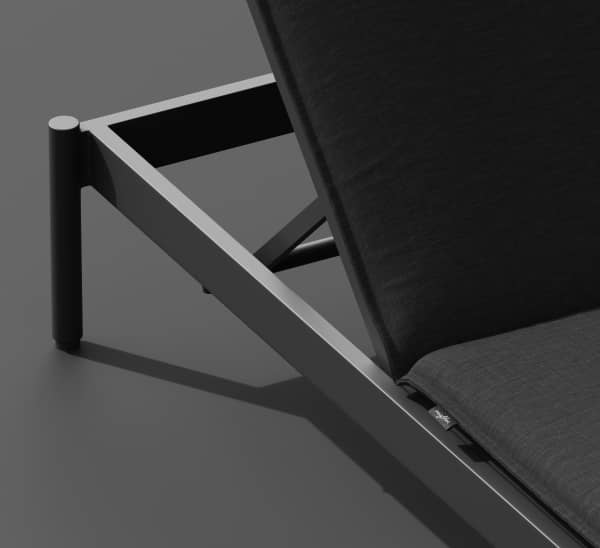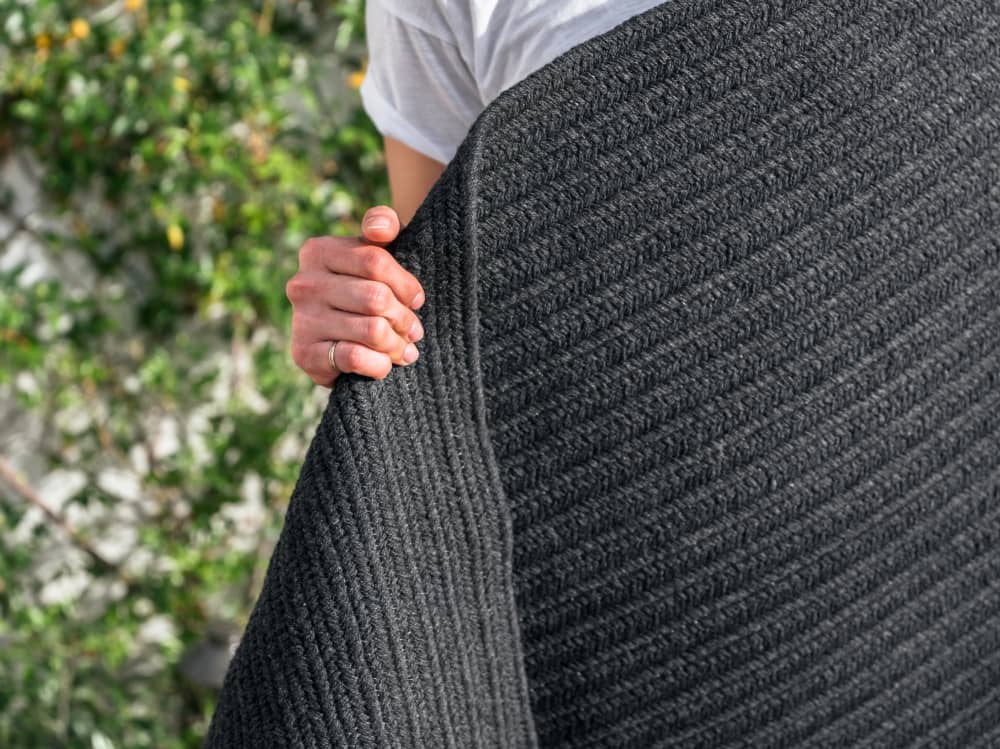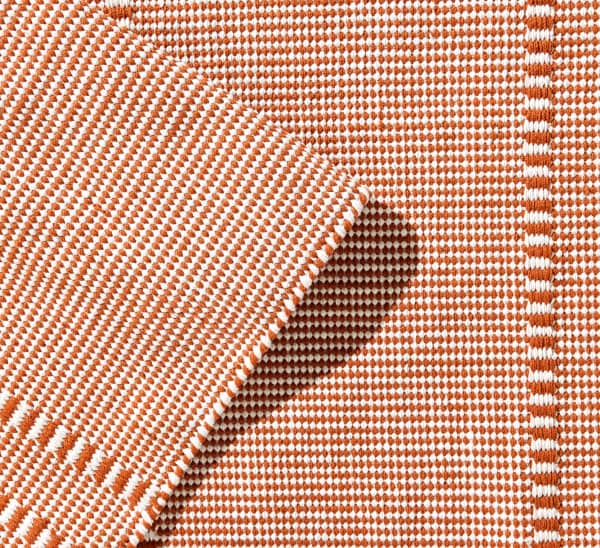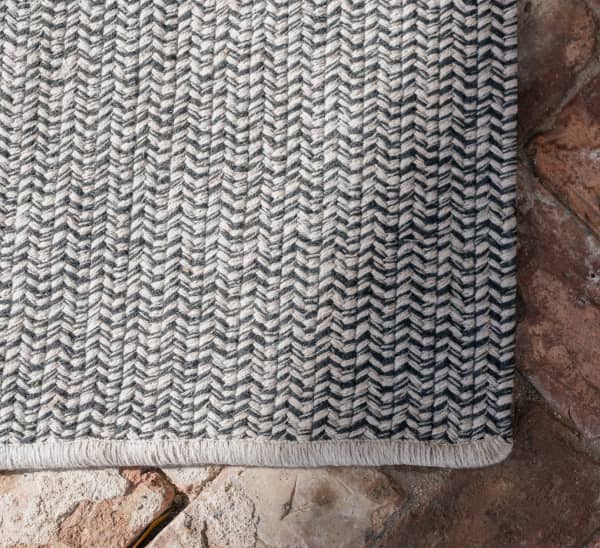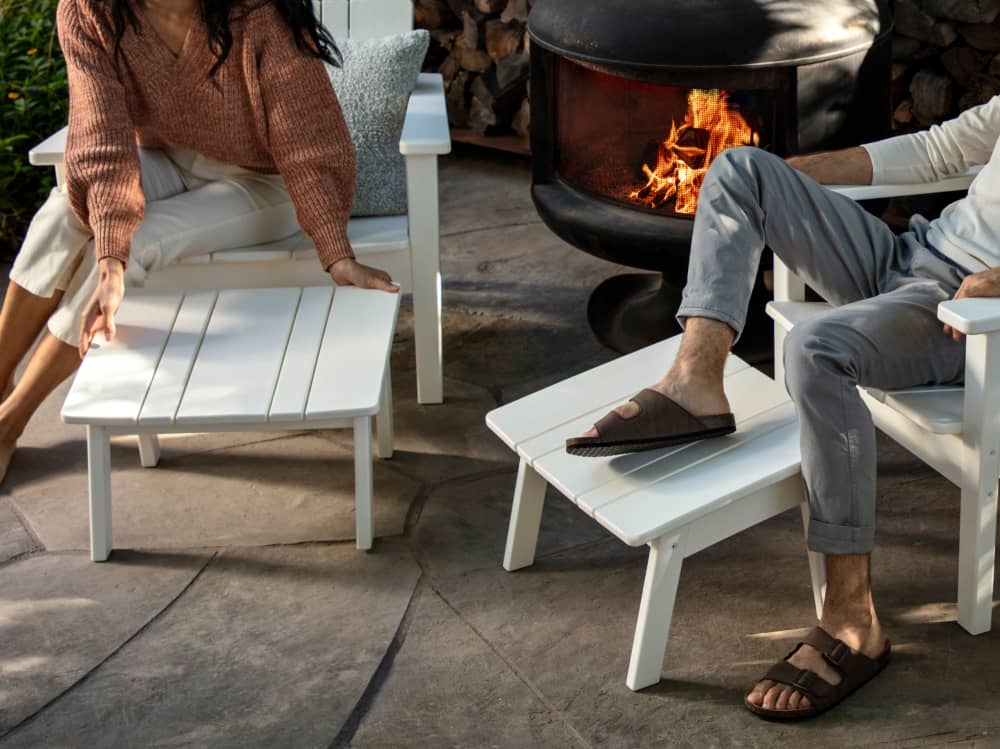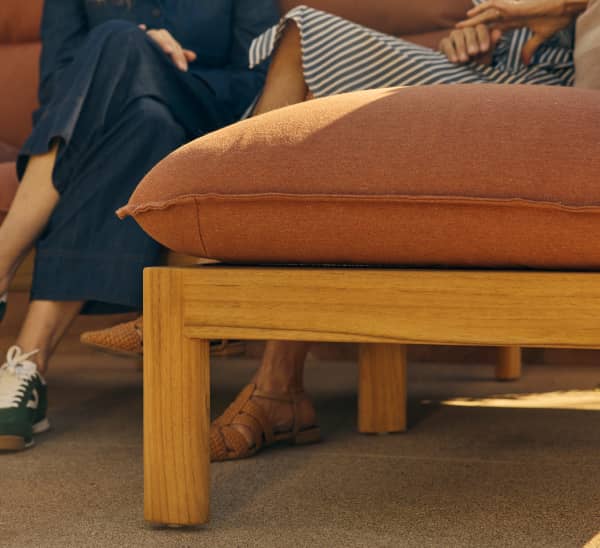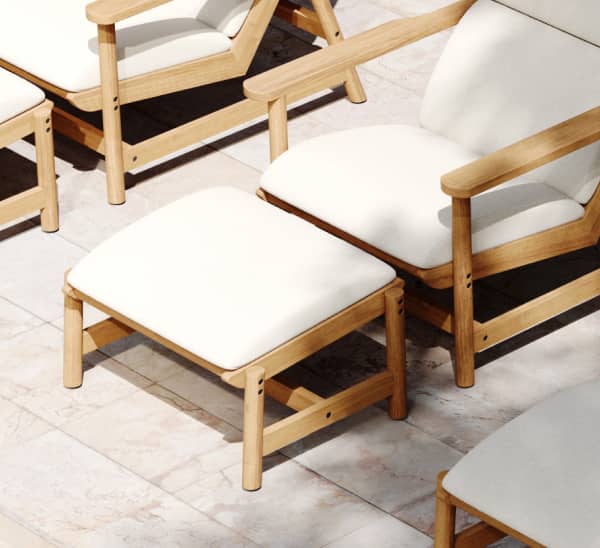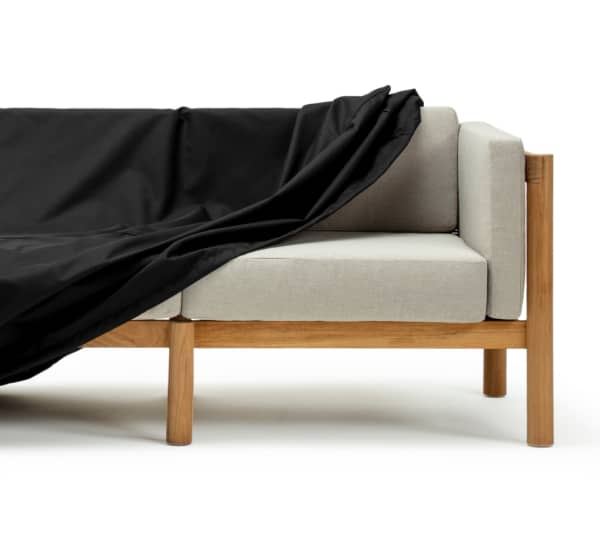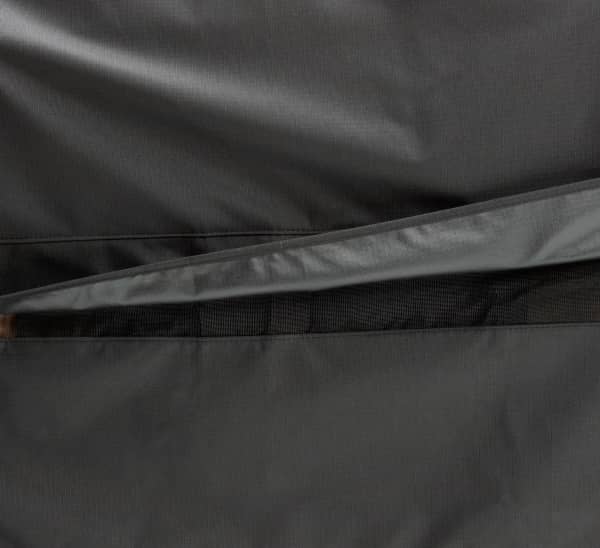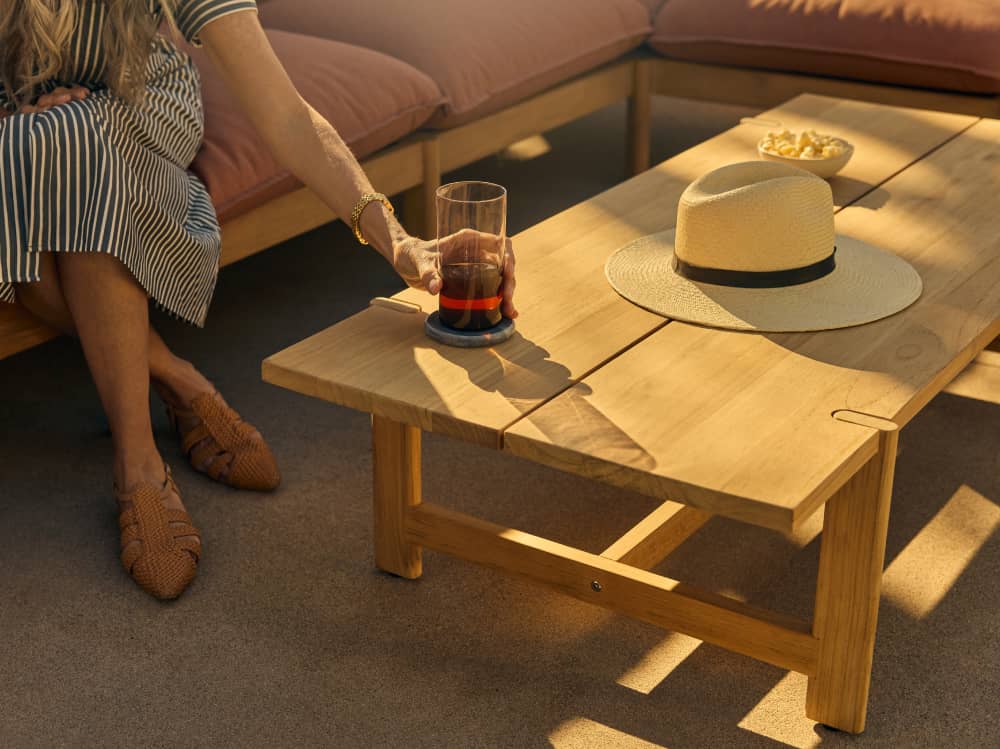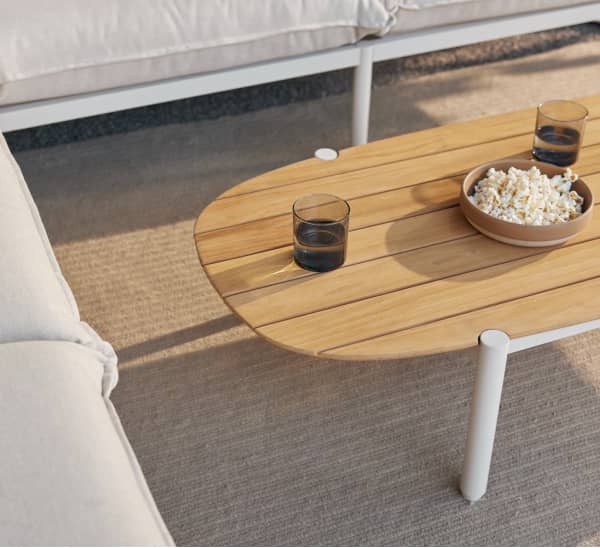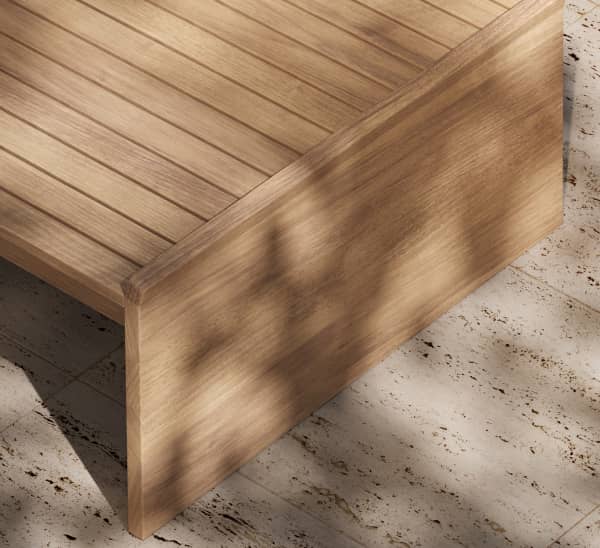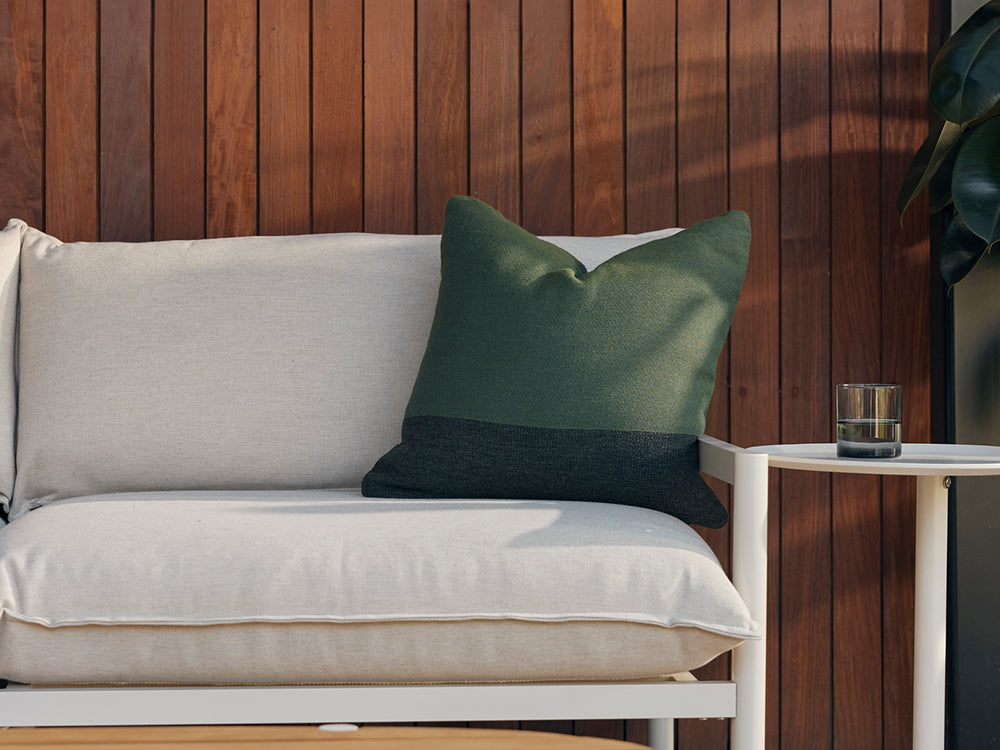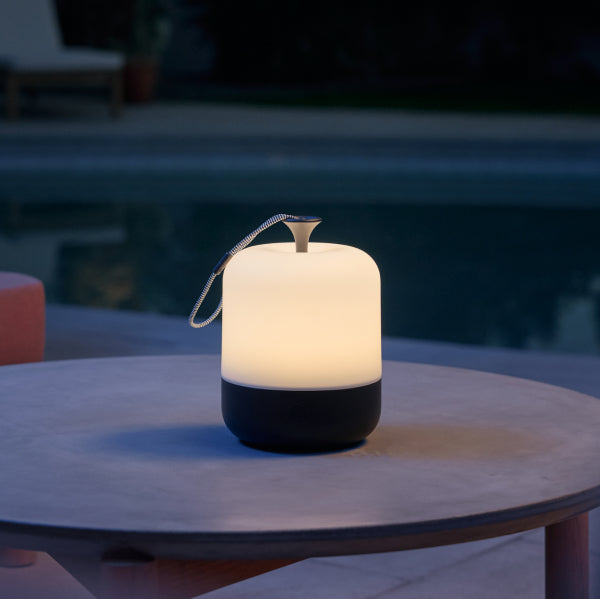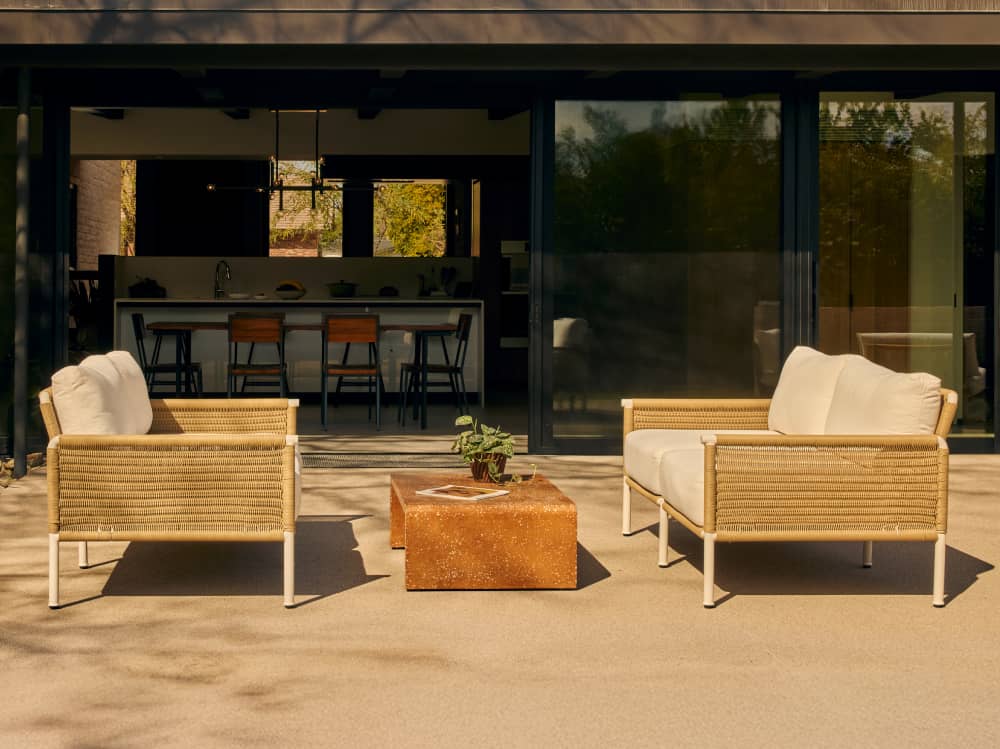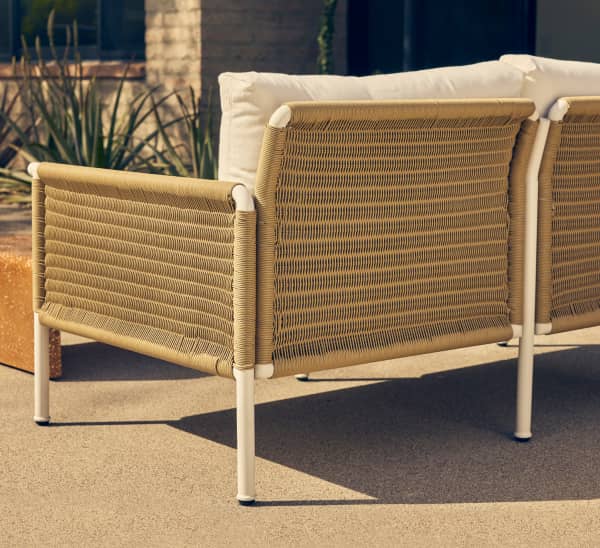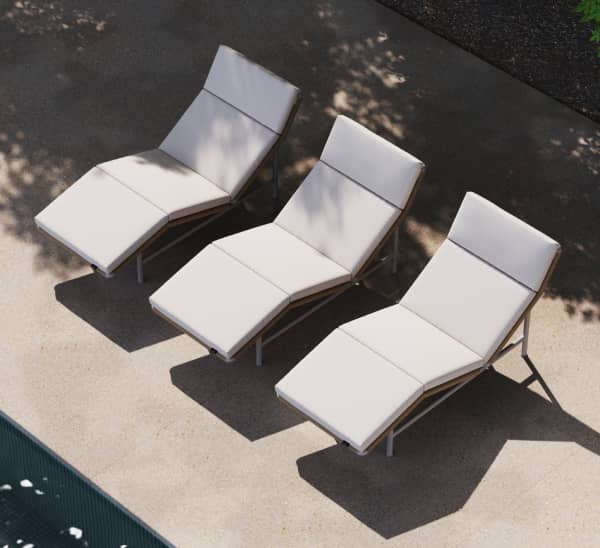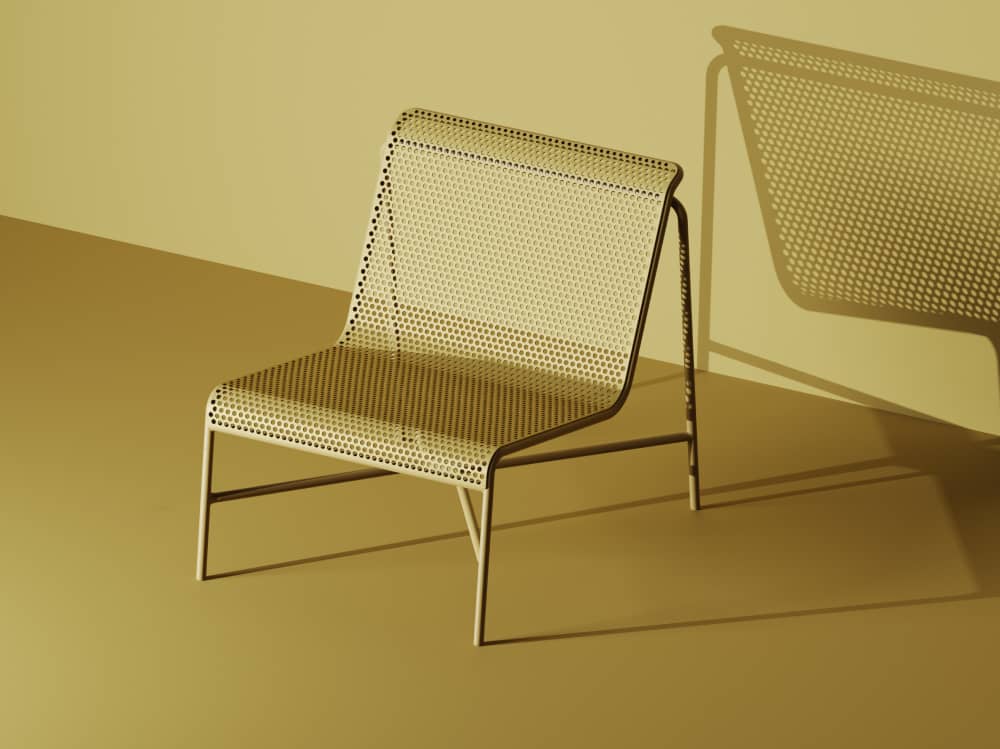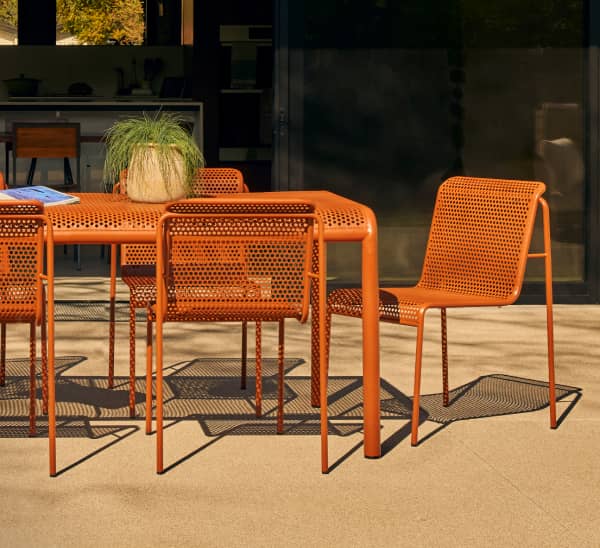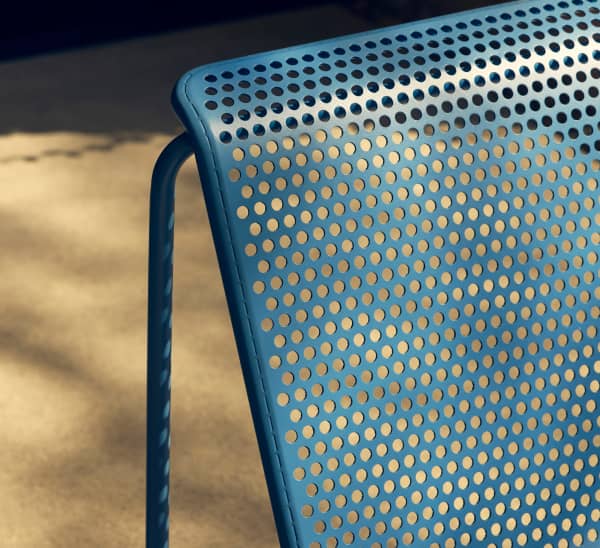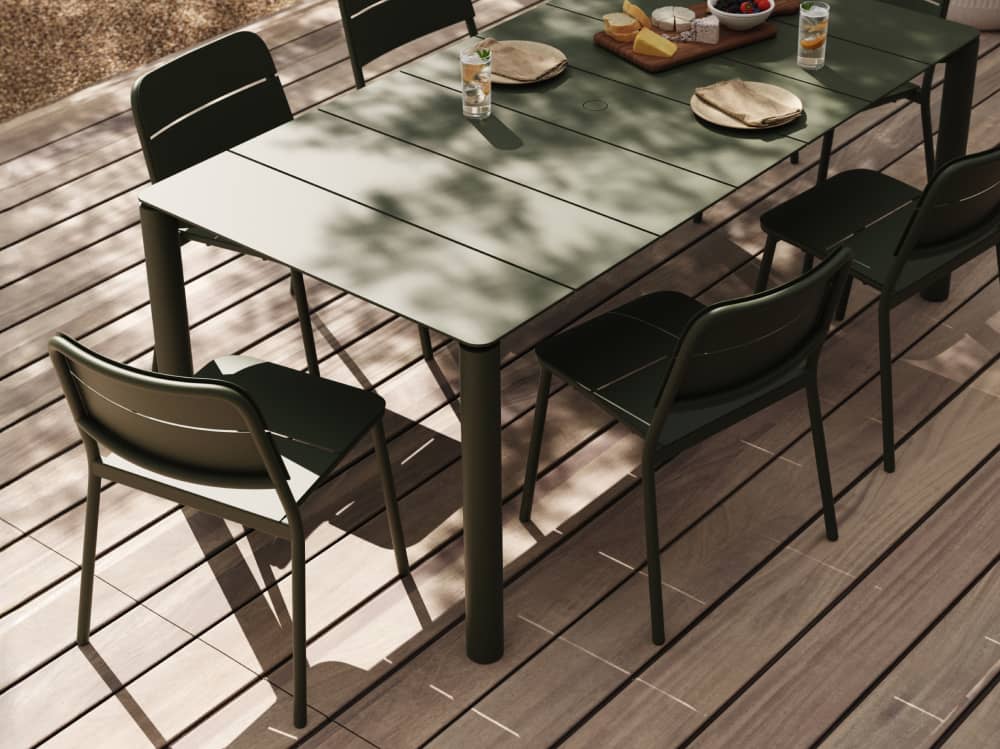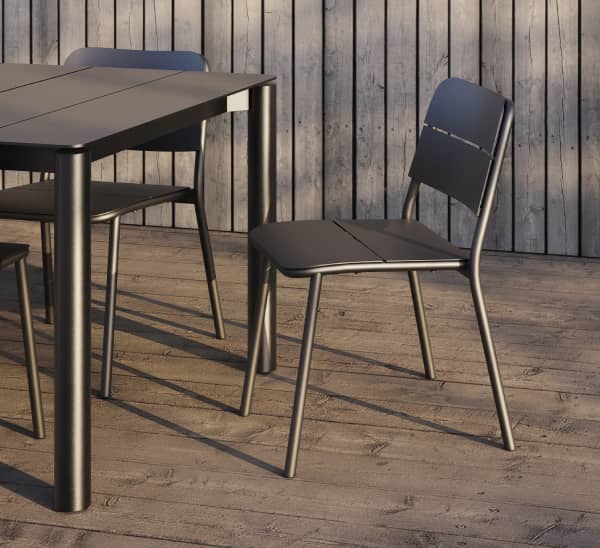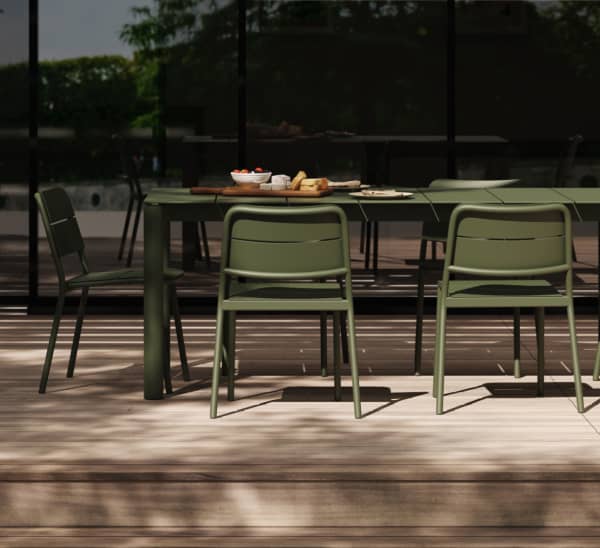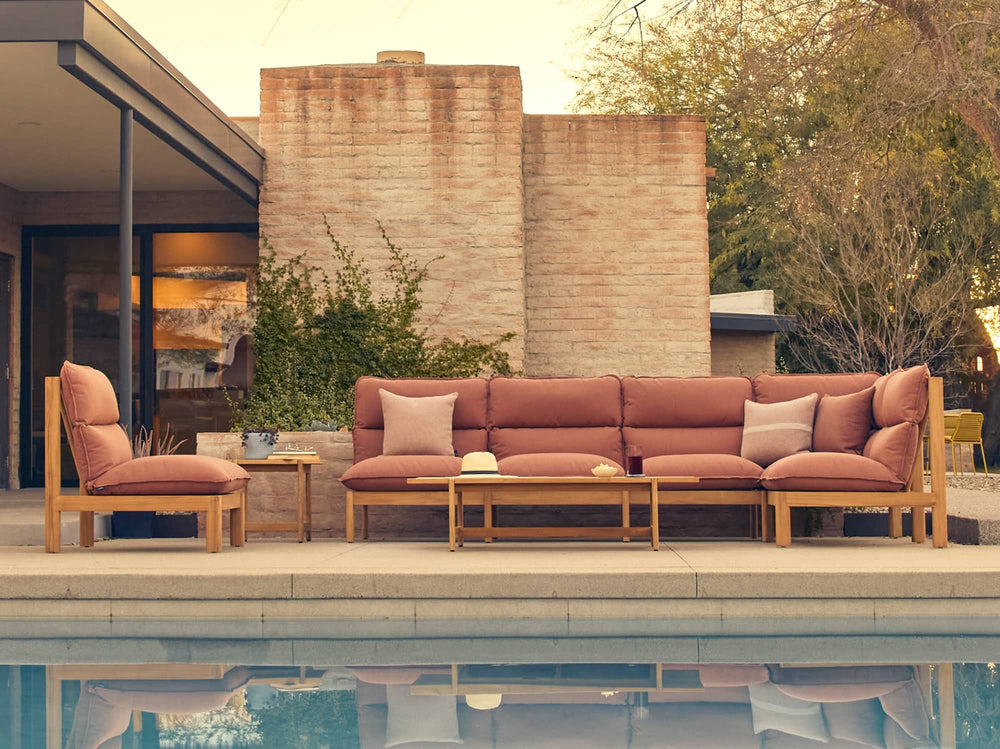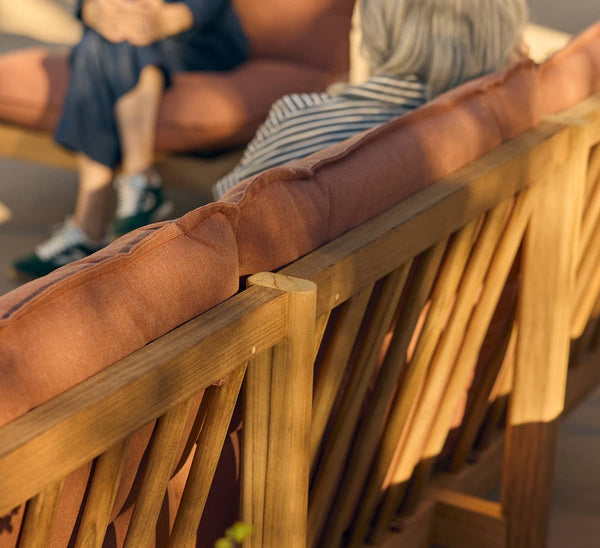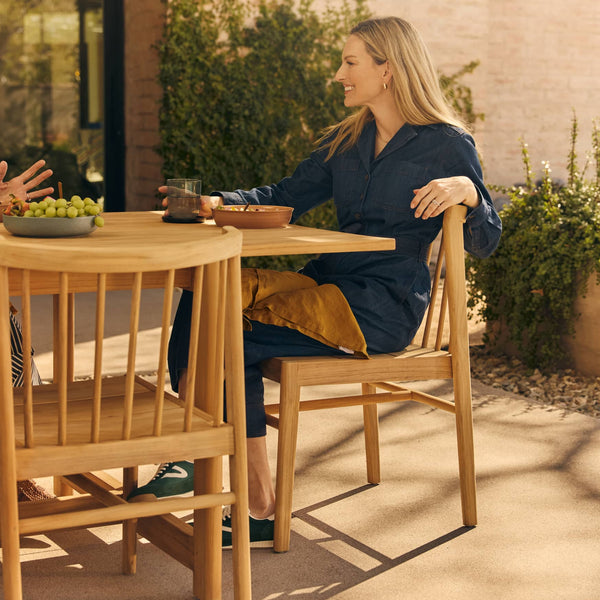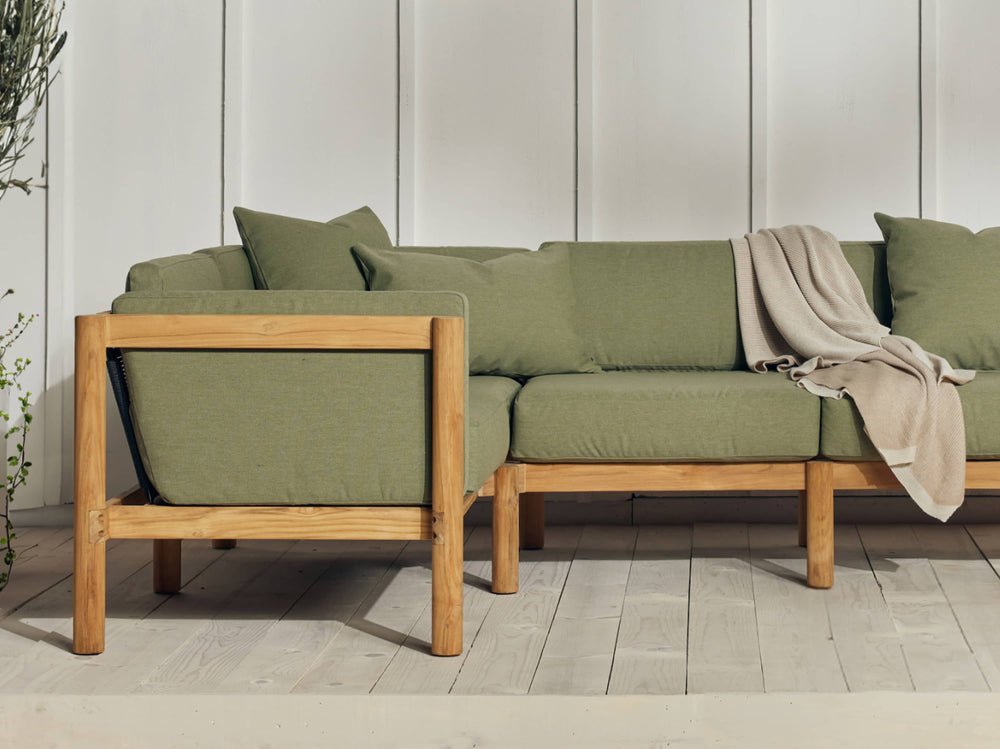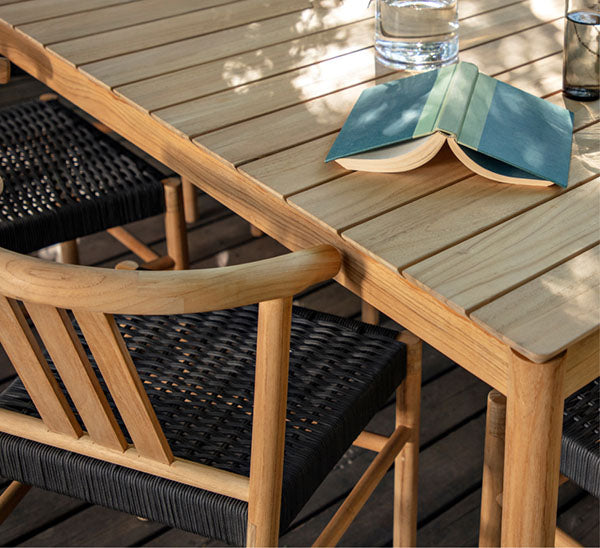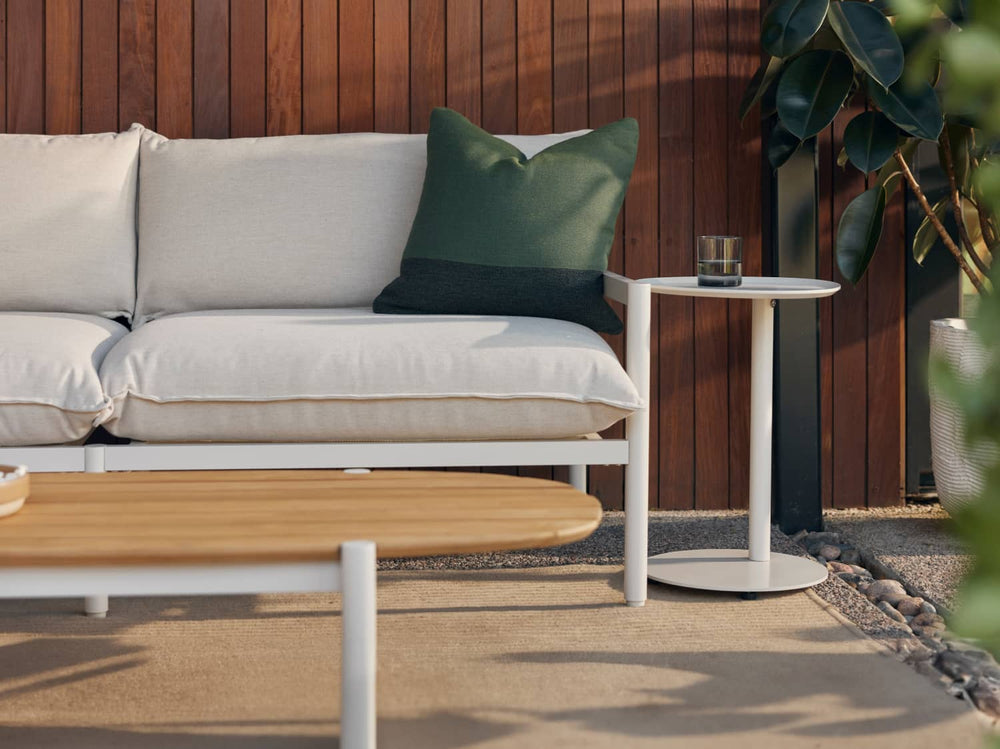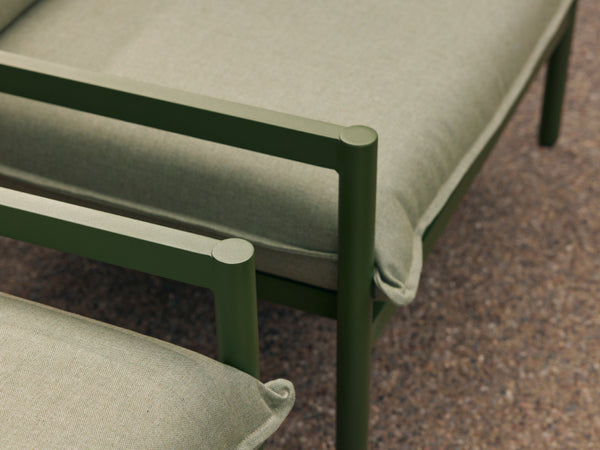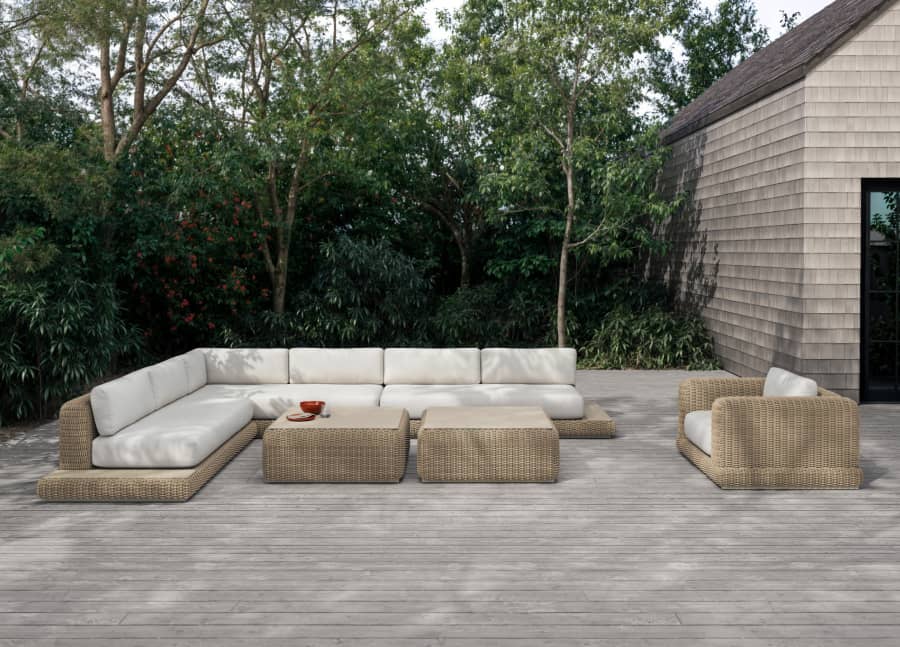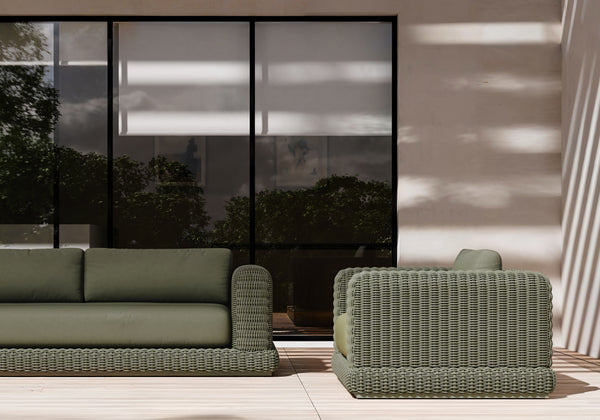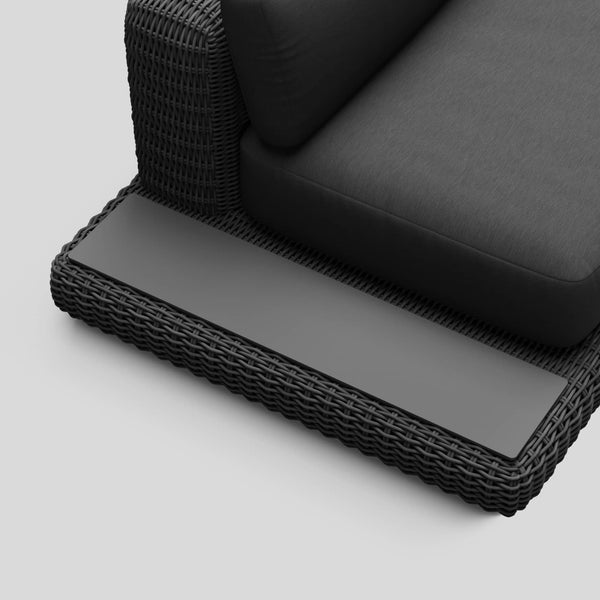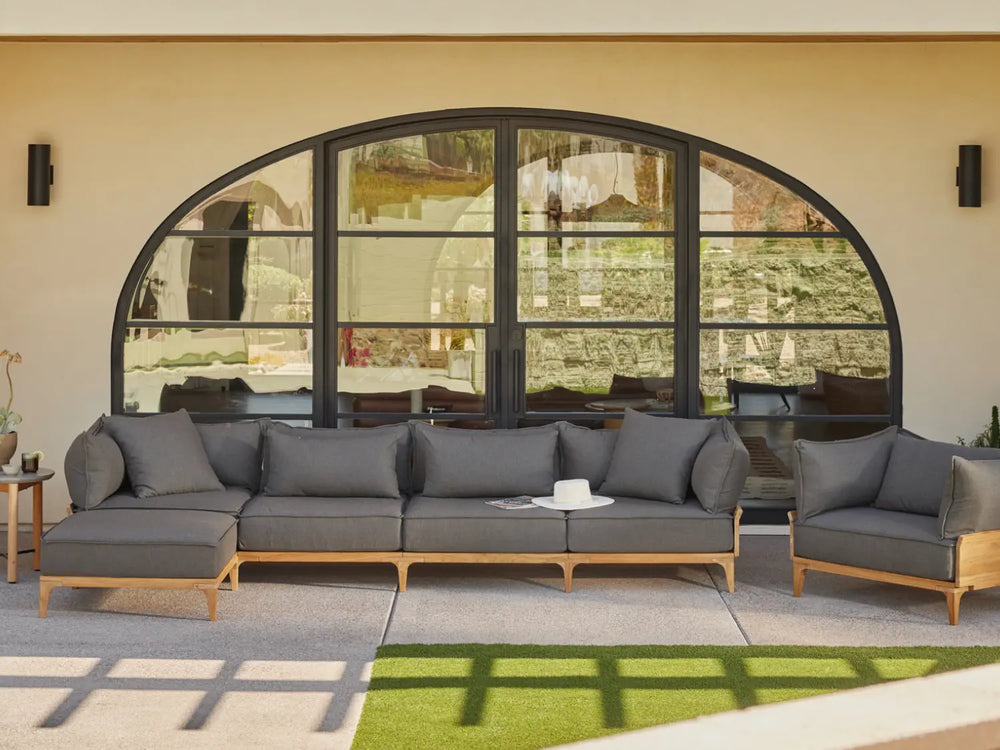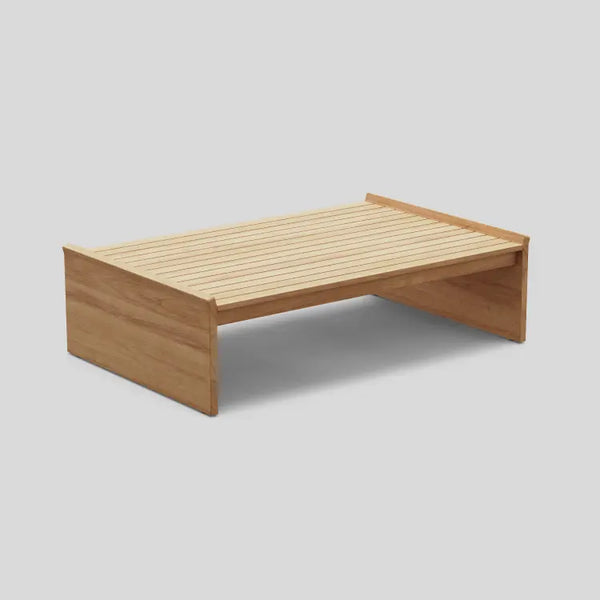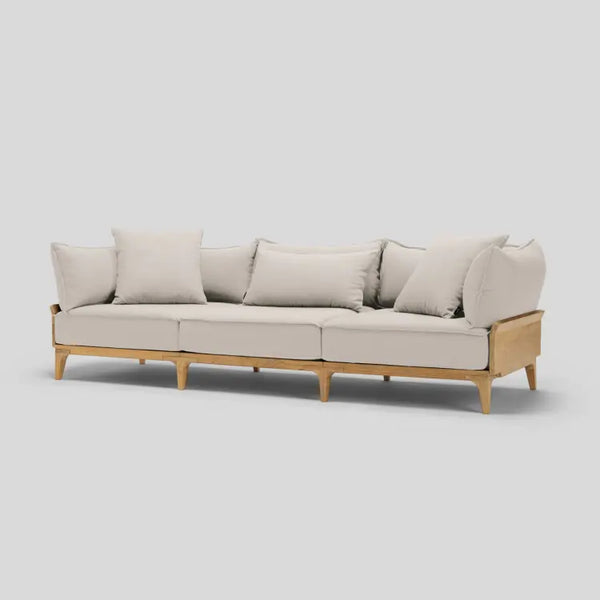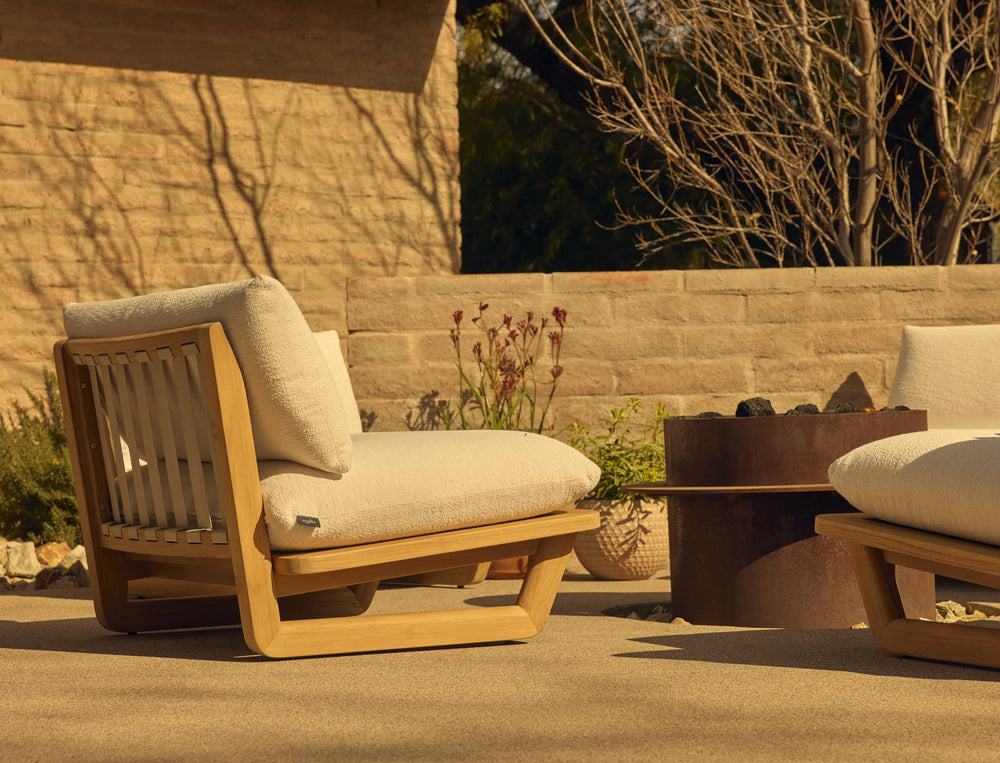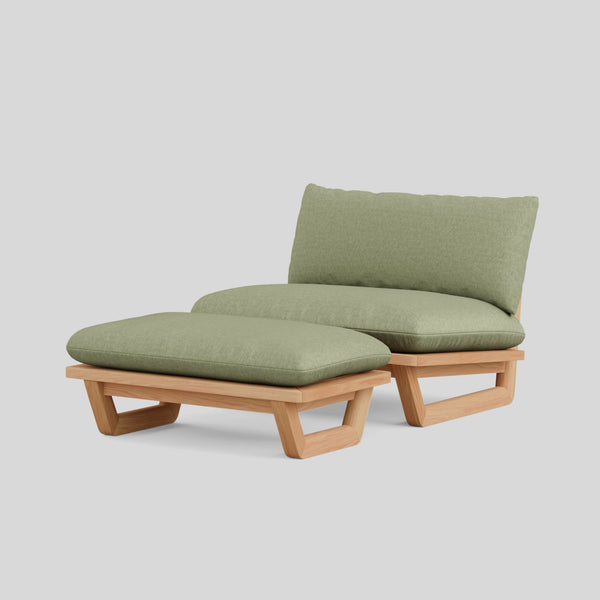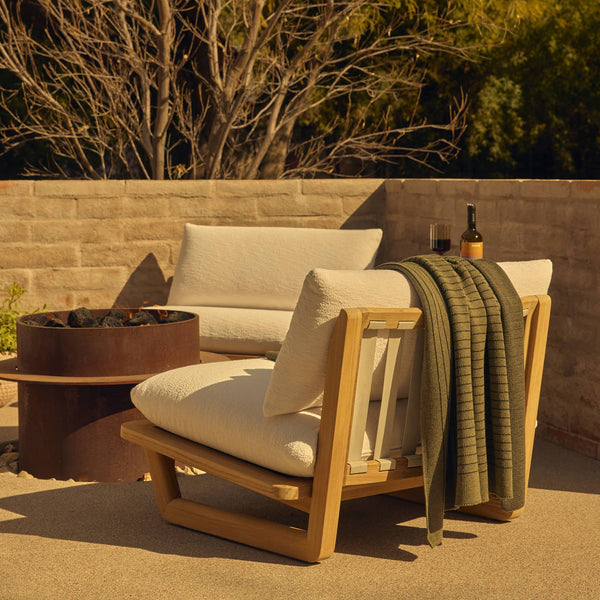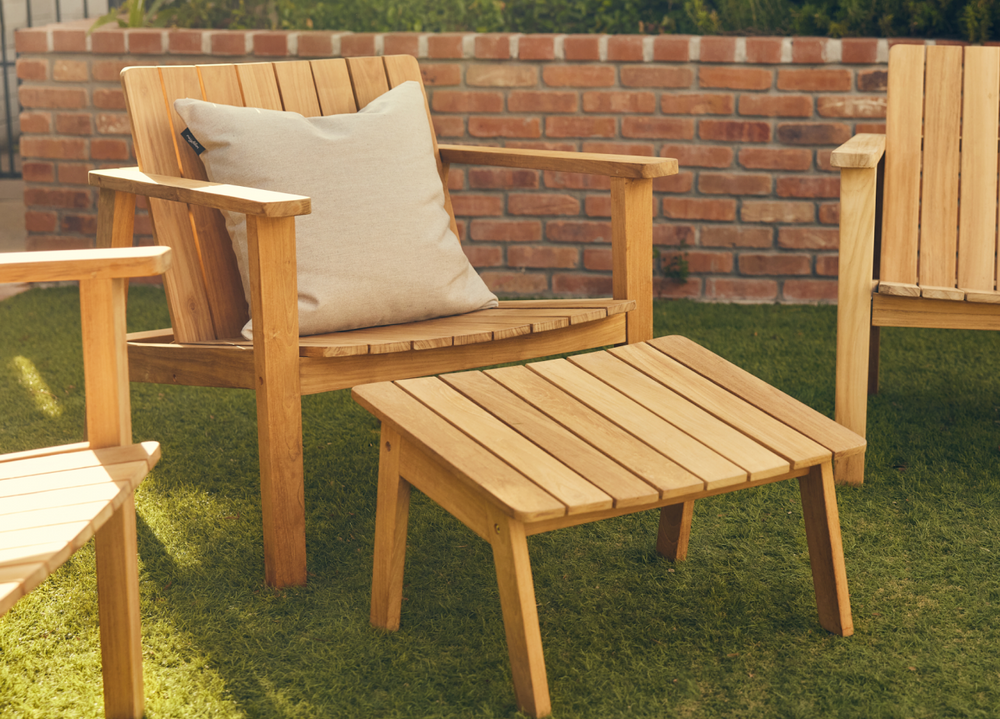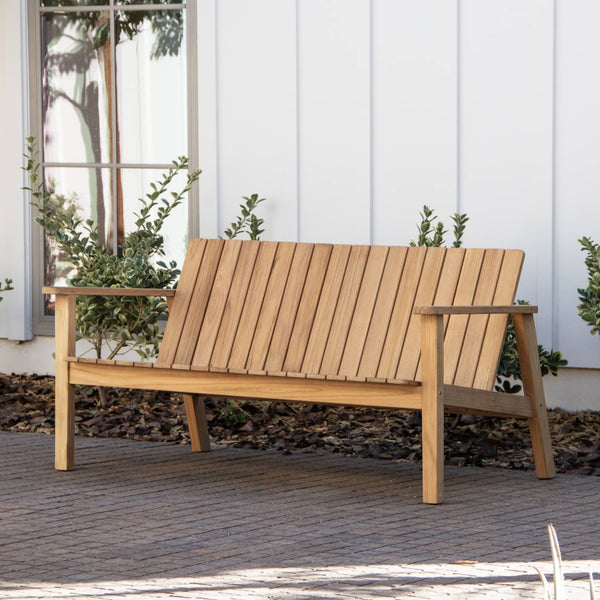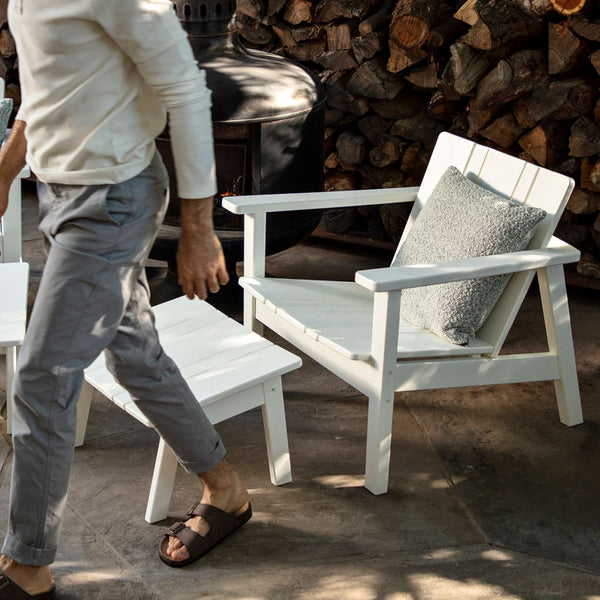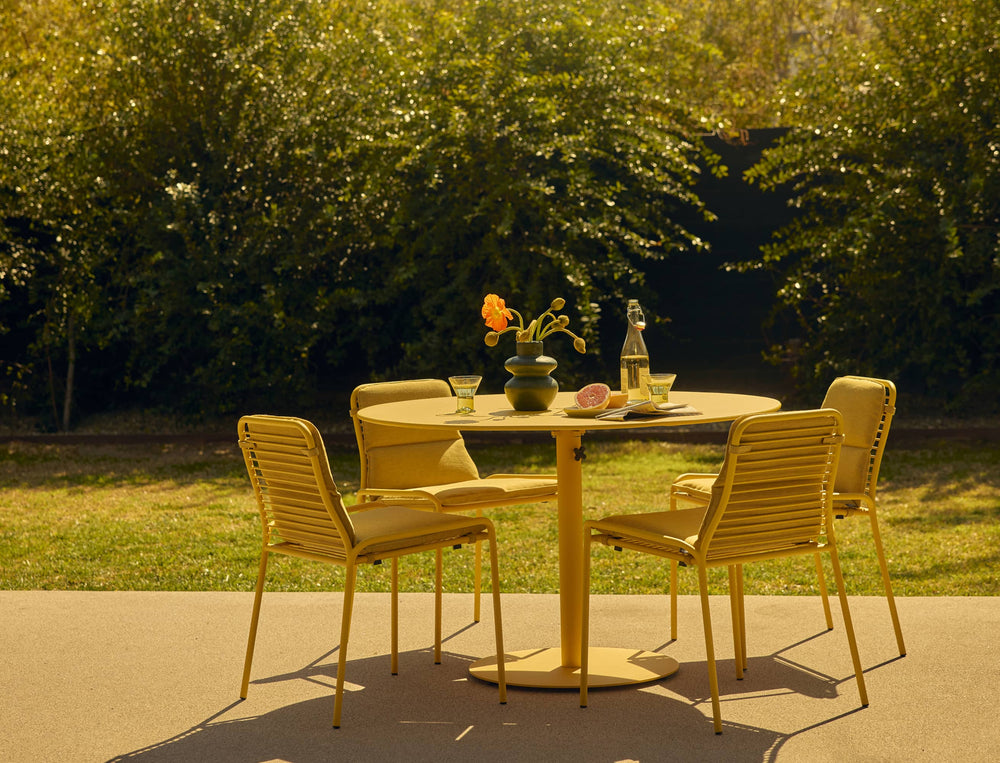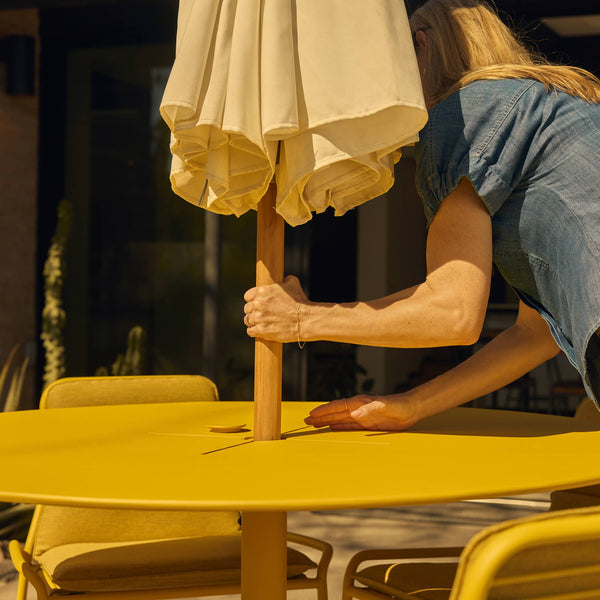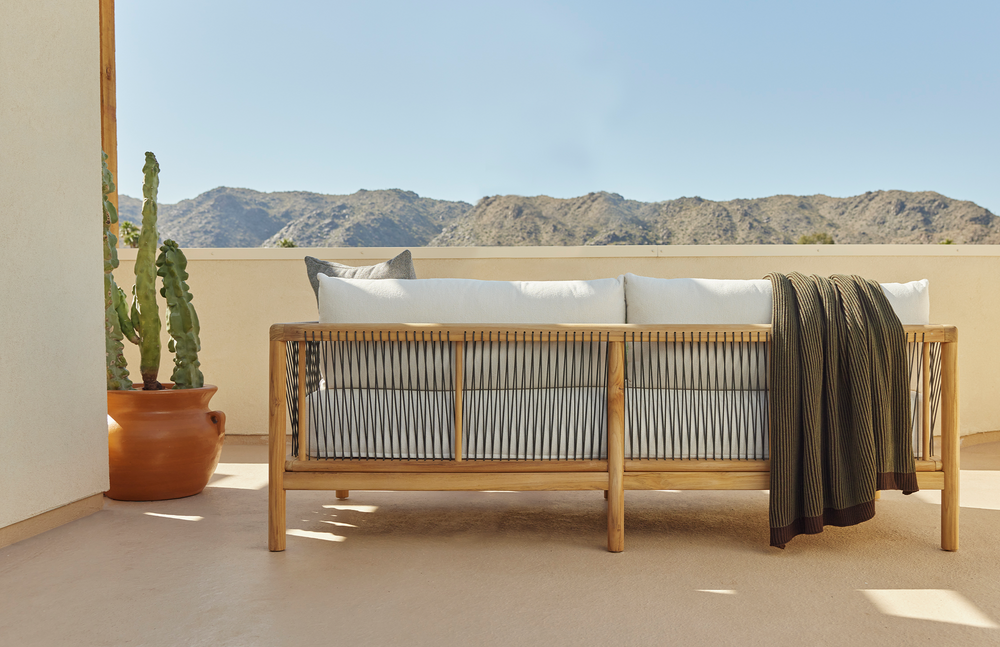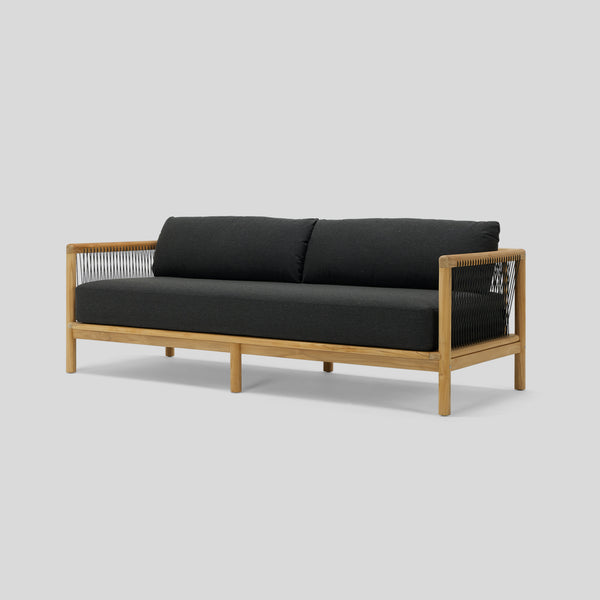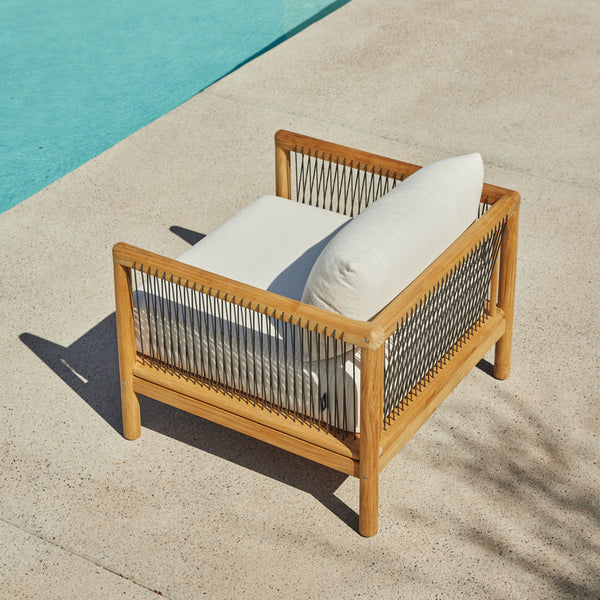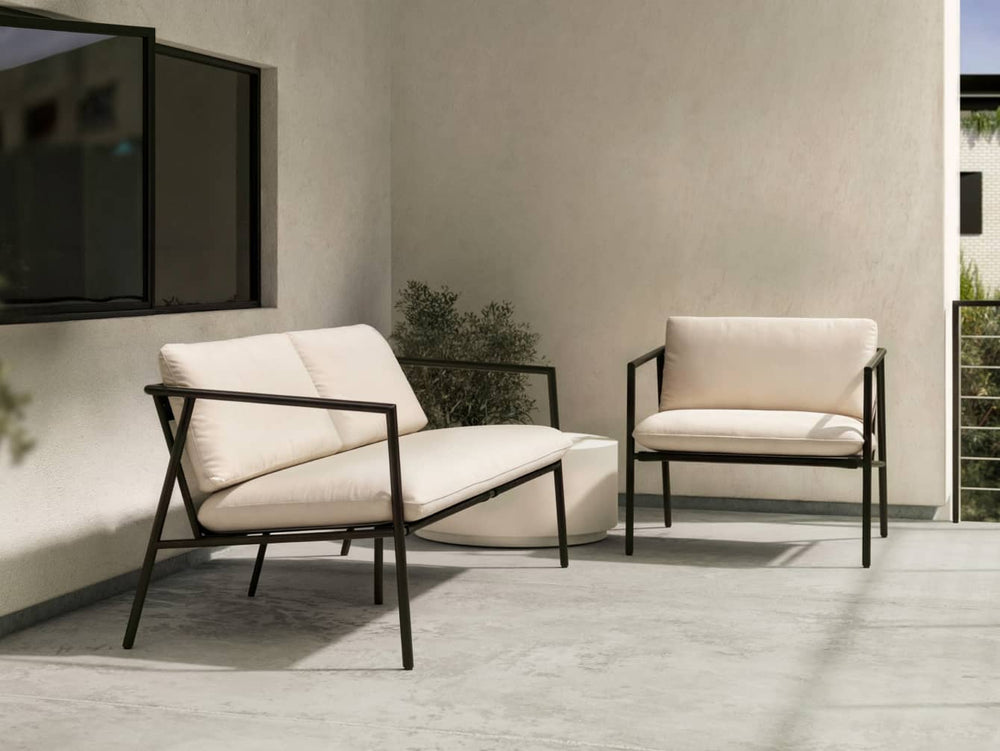Complete Guide to Recycled Plastic Patio Furniture
Written by Neighbor Editorial Team | @neighboroutdoor | Opens in a new window. |

Design an outdoor space with durable furniture that is environmentally friendly, compatible with a range of designs, and easy to clean and maintain. Recycled plastic furniture can boost your curb appeal and house value, while also benefiting the environment by reducing plastic waste and pollution. Discover how recycled plastic is made, how it became popularized over time, how it supports the environment through sustainability, and all the ways recycled plastic furniture can elevate your outdoor space. Here’s your guide to recycled plastic patio furniture and sustainable solutions:
What is recycled plastic?

Recycled plastic is a material made from a variety of plastic items, such as water bottles, plastic containers, milk jugs, plastic bottle caps, and shampoo bottles that would otherwise be sent to landfills. These plastic consumer items are recycled and transformed into a type of high-quality plastic lumber that resembles wood in both feel and appearance.
The problem
According to the EPA (US Environmental Protection Agency), an estimated 9 million tons of furniture are tossed in landfills every single year. ‘Fast furniture’ stores that manufacture hundreds of new furniture models each year to keep up with current trends are contributing to the problem. Fast-manufactured pieces aren’t built to last and are often manufactured with irresponsibly-sourced lumber or materials that are not recyclable. These are the types of furniture that end up in landfills at an alarming rate.
The solution
Choosing quality furniture from sustainable manufacturers is the solution. When you’re in the market for outdoor furniture, explore companies that are committed to responsible harvesting of woods (like teak wood) and sustainably-sourced materials (like recycled plastic). Outdoor furniture made from durable, long-lasting materials will not require yearly replacing. In fact, Neighbor’s sustainable furniture can last a lifetime with the proper care. Furniture has the ability to last for generations, not seasons. Opting for sustainable outdoor furniture materials and environmentally-friendly manufacturers helps to reduce waste and conserve natural materials, while creating a comfortable and inviting outdoor space for relaxation.
The progress
Furniture manufacturing has taken a more economical, minimal-waste turn over recent years. Consumers are demanding more eco-friendly products, and companies like Neighbor are more than happy to deliver. Recycling programs started to popularize in the late 1980s, as post-consumer plastics began piling up with no place to go, except our oceans. The question of ‘how can we make use of all this plastic?’ was weighing heavy on eco-conscious minds. This led to the solution of converting plastics into durable, recycled furniture designs. Both consumers and companies started to understand the benefits of using long-lasting plastics to create patio furniture that wouldn’t contribute to the pollution problem. Alas, plastic lumber was born.
Sustainable patio furniture materials
Wood furniture can be sustainable with safe forest practices. Teak, for example, is an ideal outdoor furniture material due to its weather-resistant natural oils, but irresponsible harvesting of teak has a negative environmental and social impact. Neighbor is dedicated to using teak harvested from FSC-certified forests, which ensures that our outdoor furniture is sustainably-sourced and responsibility-harvested. We also choose to use recycled plastic made with ocean and landfill-bound HDPE (High Density Polyethylene) plastic by POLYWOOD to support sustainable initiatives and create highly-durable furniture designs. When you purchase recycled plastic or responsibly-harvested teak outdoor furniture, you become a part of the economical solution.
What are the pros of buying recycled plastic furniture?

Sustainability
Recycled plastic furniture manufacturing has a significant, positive effect on collective consumer waste. This process reduces waste by turning waste products into beautiful, functional outdoor furniture pieces. Recycled plastic furniture is both recycled and recyclable. That means if you choose to replace your outdoor furniture in the future (although you shouldn’t have to for years ahead), you can recycle your current outdoor setup to prevent waste and continue the ‘green’ cycle.
Durability
Recycled plastic is actually known to be more durable and resistant to damage than many wood materials. Because plastic lumber is made from a mix of strong, impermeable plastics, furniture made from this material can stand strong for years without cracking, splitting or fading in color. HDPE is actually known for its large strength-to-density ratio, meaning its ability to withstand damage under pressure or impact is exceptional. Recycled plastic isn’t likely to incur damage, making it the perfect material for outdoor furniture exposed to the elements.
Waterproof
Plastic is waterproof - as evidenced by your fridge full of plastic containers that aren’t leaking. Recycled plastic furniture can sit through heavy rains and be exposed to the open ocean without being damaged. This material is impermeable to water and resists mold, mildew and fungi. Recycled plastic furniture is ideal for any environment, especially areas with high humidity and salt in the air. HDPE plastic creates a powerful barrier between your furniture and the elements. If you live in a coastal region, you don’t have to worry about recycled plastic furniture warping (like some woods), rotting, fading or attracting insects.
Design compatibility
In terms of both functionality and aesthetic appeal, recycled plastic furniture is easily paired with other patio furniture materials. Recycled plastic offers a lot of variation in color and style. This material pairs well with different woods, especially teak wood, and can instantly create a contemporary style.
Easy cleaning
Recycled plastic doesn’t require any special cleaning techniques or intensive maintenance. Dirt, dust and grime can be removed with a simple water solution or a quick hosing down. Plastic lumber is resistant to staining. Spills can be easily absorbed with a clean towel, and they won’t leave a ring of discoloration behind. Plastic furniture won’t absorb water, and therefore, does not require special care throughout the seasons.
Lightweight
With a lightweight composition, recycled plastic furniture is easily moved, rearranged or stored away without hassle. If you regularly rearrange your outdoor patio to accommodate guests or to reflect an ever-evolving style, recycled plastic furniture is an easy furniture solution. When you hear “plastic furniture” you may think of flimsy, flexible plastic materials. Plastic lumber is lightweight, but not so lightweight that your furniture set goes airborne in high winds. Plastic lumber is sturdy and durable enough to withstand strong gusts of wind without damage.
Deforestation
As more trees are cut down in irresponsible furniture manufacturing processes, this has a negative environmental and social impact. The earth loses the natural air filtration that trees provide, which increases the concentration of carbon dioxide in the air, creating a harmful greenhouse effect and contributing to climate change. Purchasing plastic lumber helps to conserve wood lumber, while reducing plastic waste and pollution. POLYWOOD plastic lumber is infinitely reusable, and 99% of all scraps from manufacturing goes right back into their recycling plant to be made into lumber. Due to the zero-waste manufacturing process of recycled plastic, this helps reduce deforestation by decreasing the need for wood materials while simultaneously diverting plastic waste from landfills and other polluted areas.
How is recycled plastic made?

To create recycled plastic outdoor furniture, post-consumer plastics are melted down and molded into a plastic lumber that resembles high-quality natural wood. Recycled plastic can then be designed into a variety of shapes, sizes and colors that other outdoor materials cannot yield. While the plastic is melted, dyes are mixed with the material to ensure thorough coloration throughout the material before molding. This powerful coloration process prevents the color from fading, prevents scratches from lifting the color and prevents the need for post-manufacture polishing.
How do I care for recycled plastic patio furniture?
Caring for recycled plastic patio furniture is simple. Liquids wipe right off, stains can be wiped away with ease, and weather-proof qualities prevent the need for storing outdoor furniture away for the winter. You can use a soft-bristle brush or sponge along with soapy water to wipe down stains or spills. If necessary, you can also use a diluted bleach solution to clean your recycled plastic furniture without risking water damage or color fading. Recycled plastic pieces can be hosed down or pressure washed (below 1,500 psi) as an easy and effective cleaning method. Follow the following steps to clean and sanitize recycled plastic outdoor furniture:
- Mix mild dish soap and warm water in a bucket.
- Use a clean cloth to apply the soapy water onto the surfaces of your furniture.
- For deeper stains, mix 1/3 bleach and 2/3 water.
- Apply the cleaning solution to furniture with a clean cloth and allow it to sit on the plastic lumber for a few minutes.
- Scrub the cleaning solution with a soft-bristle brush to loosen any dirt or debris from grooves in the lumber.
- Rinse your furniture thoroughly and allow it to air dry.
With a little maintenance, your recycled plastic furniture will stand beautifully through the seasons.In regions with freezing temperatures, it may be best to cover plastic chairs with a protective furniture cover to prevent ice from freezing on the surface. This could lead to warping.
Low chair; the perfect recycled plastic outdoor chair

Neighbor’s low chair features recycled ocean and landfill-bound HDPE plastic by POLYWOOD plastic. Sustainability-made, beautifully-designed and exceptionally comfortable, our recycled plastic chair is made with both the environment and the buyer in mind. The low maintenance, easy-to-clean, modern Adirondack chair and ottoman offer a sophisticated yet versatile style that complements any patio or garden space. With a modern spin on the classic Adirondack chair, the low chair is sturdy with a relaxed recline, curved back and wide armrests. Also available in beautiful teak wood, the low chair can help you transform your outdoor space into the backyard of your dreams.
20-year warranty
Due to the durability of quality HDPE plastic, Neighbor offers a 20-year warranty on the low chair. It’s water-proof, fade-resistant, maintenance-free and made to withstand all seasons and the heaviest storms.
Recycled plastic vs. other outdoor furniture materials
When it comes to sustainability, durability and appearance, the most comparable furniture material would be teak wood.
Appearance
Teak wood and recycled plastic are highly versatile materials that are easily paired with other materials and designs. Teak wood offers a honey-gold color that gradually patinas to a warm silvery-gray. Teak furniture can be fashioned with outdoor cushions that come in a wide range of colors. (Neighbor uses trusted Sunbrella® outdoor fabrics for all of our cushions.) Recycled plastic comes in a wide variety of colors, from neutrals to bright hues. Although not necessary for comfort, seat cushions can also be added to recycled plastic furniture.
Maintenance
Teak wood and recycled plastic are excellent materials for a low maintenance outdoor space. Teak wood is low maintenance, aside from an occasional cleaning. You can also apply a teak protector/sealant to prolong the original appearance of your teak furniture. Teak wood is still weather-resistant and will not absorb water or moisture. Recycled plastic requires virtually no maintenance. It won’t lose its color or fade, and it won’t absorb water in the heaviest rains. Recycled plastic furniture can be hosed down for a quick washing when necessary.
Sustainability
When purchasing outdoor furniture, you can do your part to support the environment by researching where the materials came from, how the company sources raw materials, and which initiatives the company takes to reduce their impact on the environment. To determine whether a company uses sustainably-sourced woods for teak furniture, look for a wood certification, like FSC (Forests Stewardship Council), SFI (Sustainable Forestry Initiative) or ATFS (American Tree Farm System). Neighbor is proud to use teak harvested from FSC-certified forests. FSC-certified wood comes from responsibly managed forests that provide environmental, social and economic benefits. Recycled plastic furniture uses a sustainable process to convert plastic waste into stunning, long-lasting outdoor furniture. Neighbor is proud to feature POLYWOOD plastic lumber in the timeless low chair with 100% recycled plastic. Both POLYWOOD and Neighbor have a mission to help people create beautiful outdoor spaces where they can make lasting memories for generations.
Types of Plastic Furniture

There is a wide variety of outdoor furniture made from recycled plastic. Due to the molding process in recycled plastic furniture manufacturing, almost any type of patio furniture can feature this sustainable material. POLYWOOD, for example, offers a variety of chairs, chair sets, dining tables, coffee tables, side tables and deck materials. The two main types of plastics used for outdoor furniture materials include thermoplastic and thermosets. Thermoplastics can be melted with heat after being cured, while thermosets retain their original form with exposure to heat. (HDPE is a thermoplastic.) HDPE is 99% recyclable, whereas thermoset plastic is not recyclable or remoldable once formed, making thermoplastics and HDPE the sustainable choice for outdoor furniture materials.
Recycled plastic can elevate your patio and support the environment.
When designing Neighbor’s outdoor furniture, it was essential that we found durable, weather-resistant materials that didn’t sacrifice beauty or feel. After hours of researching, designing, and testing, we decided on materials that would ensure sustainability, durability - and of course, comfort. Recycled plastic outdoor furniture can complement any outdoor space, anywhere in the world. With unique weather-resistant, fade-resistant and UV-resistant properties, recycled plastic stands strong against the elements in rain, shine, high-winds and snow. Turn your outdoor space into a private oasis and rest comfortably knowing that you won’t have to replace your patio setup or contribute to the waste of ‘fast’ furniture. Sustainable living is something to feel good about.

